|
Made With |
|
|
|
|
Dr. Hoffer's Travel WebSite This site was last updated 07/06/16 |
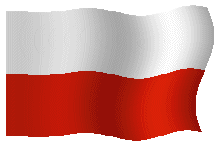
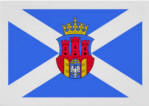
![]() POLAND13 #7
KRAK�W:
Wieliczka
Salt Mine
POLAND13 #7
KRAK�W:
Wieliczka
Salt Mine
![]()
Flag of KRAK�W

Wednesday, September 11, 2013
KRAK�W
Getting to Krakow, we have now traveled through two regions of Poland.
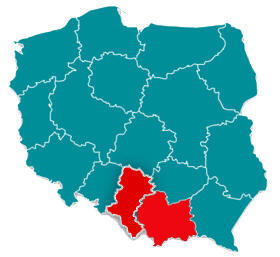
Poland has a population of almost 39 million and is the 6th most populated country in the EU. It is divided into regions called voivodships (wojew�dztwa.) These voivodeships (provinces) are subdivided into powiats (or counties,) and these are further divided into gminas (communes or municipalities.) Major cities normally have the status of both gmina and powiat. Poland has 16 voivodeships, 379 powiats (including 65 cities with powiat status) and 2,478 gminas.
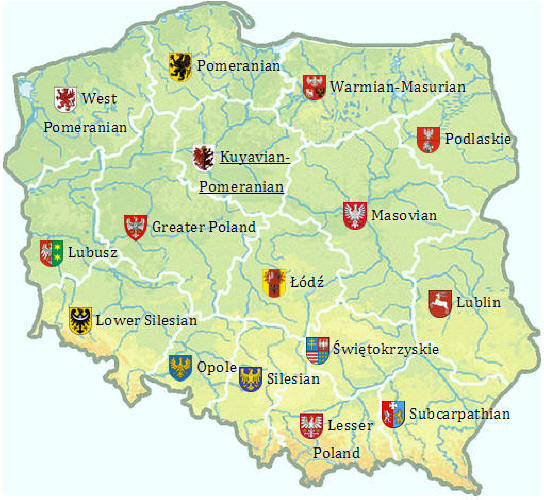
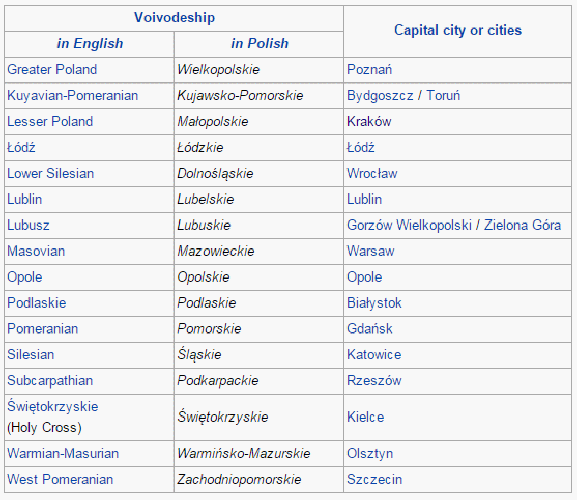
On our way here, we drove through Silesia and into Lesser (lower) Poland in the south. We will travel to Masovia (centrally) to stay in Warsaw and then through Podlachia in the north to get to Lithuania. We will return to Poland via Kaliningrad and enter Pomerania (blue) and leave Poland from there at Szczecin in West Pomerania. Therefore we will miss Warmia-Masurai and Greater (upper) Poland and several others.
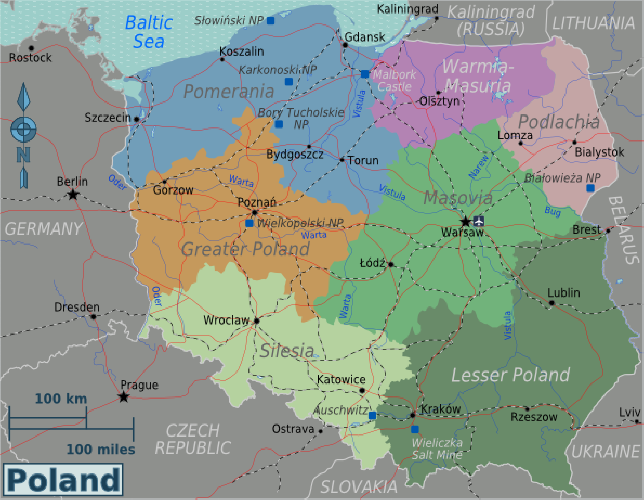
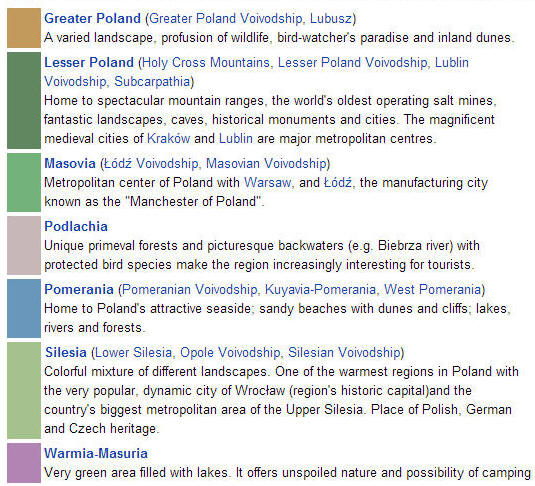
Below left is a map showing even more territorial subdivisions. The map below right shows the topography of the country. You can see it is mostly flat except for the Carpathian Mountains (brown) in the south bordering Ukraine, Slovakia and the Czech Republic.
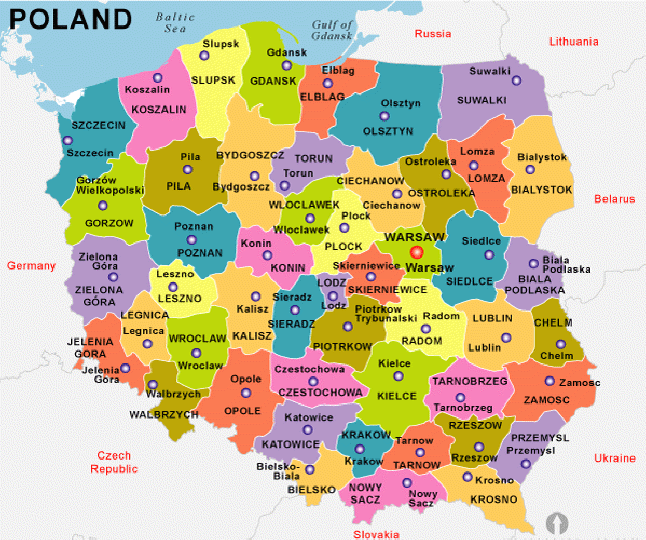
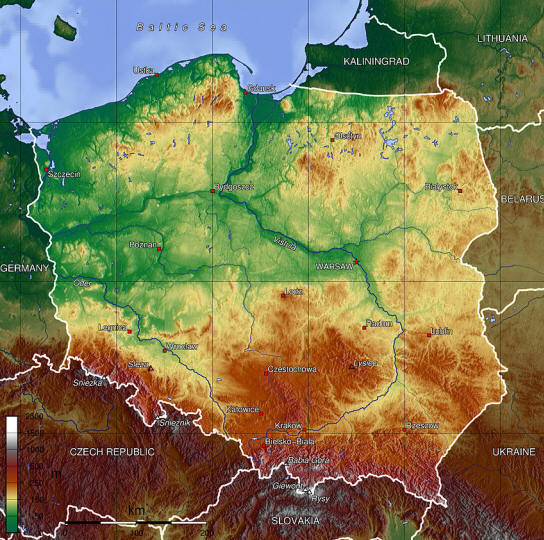
Here is a photo of a section of the mountains called the Tatras.
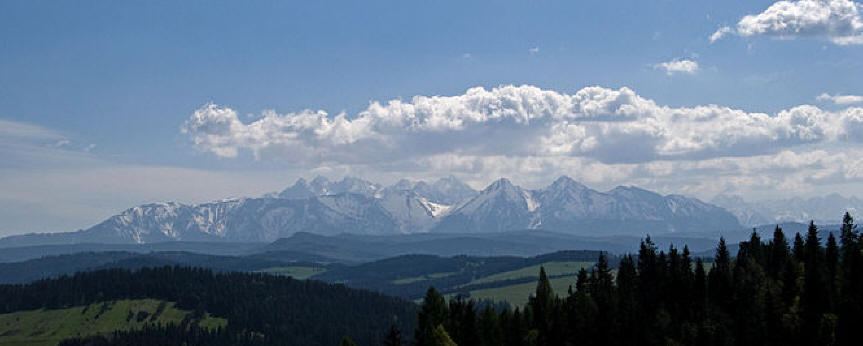
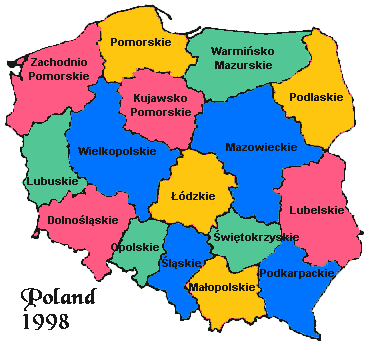
I don't think there is another country in the EU (except Italy, perhaps) that has had to go through more territorial changes and dominations throughout its history. This is probably due to its very central location sitting between major empires. At one time it was a powerhouse. The Polish�Lithuanian Commonwealth (below left) existed between 1569 and 1648 and covered all this territory (in red) from the Baltic to the Black Sea. Below right is the extent of Poland in 1920 during WWI. You can see that K�nigsberg (now Russian Kaliningrad) and Gdansk (German Danzig) were once Prussian. The Lithuanian capital of Vilnius was once Polish Wilno less than 100 years ago.
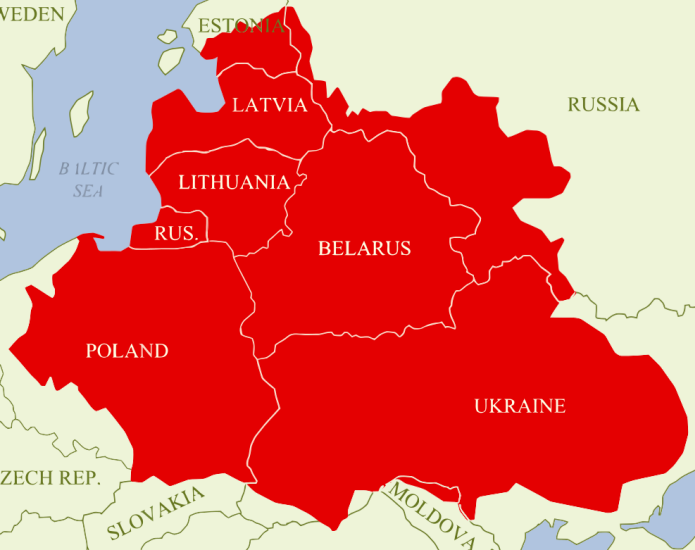
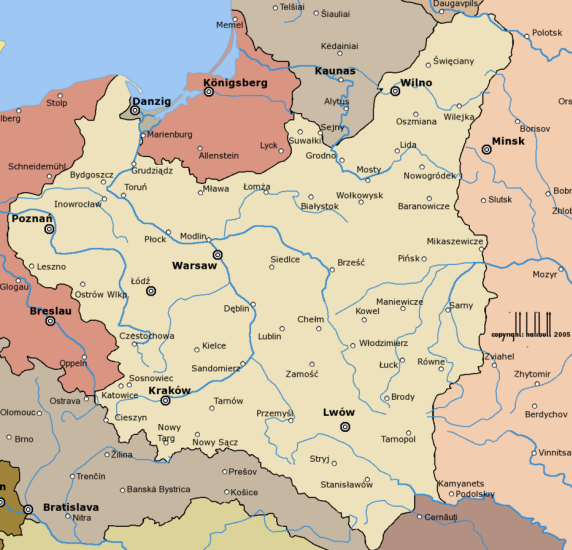
Below left is a map of Polish territory from 1920 to 1939 just before Hitler conquered it (colored areas.) On the right is the partitions that took place after WWII in 1945 where the USSR took a huge chunk (pink) of eastern Poland and then a smaller chunk of eastern Germany was added to it (yellow.)
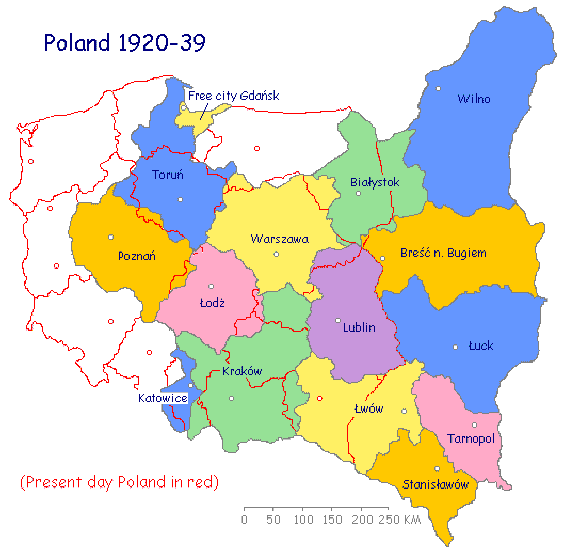
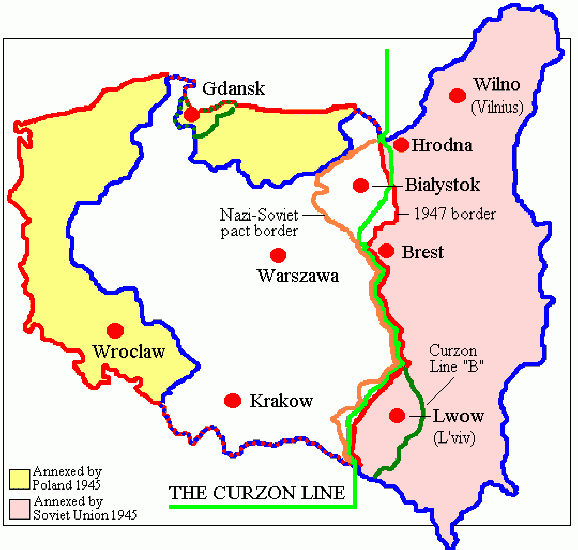
Here are some colorful maps of Poland I found showing flags and coats of arms.
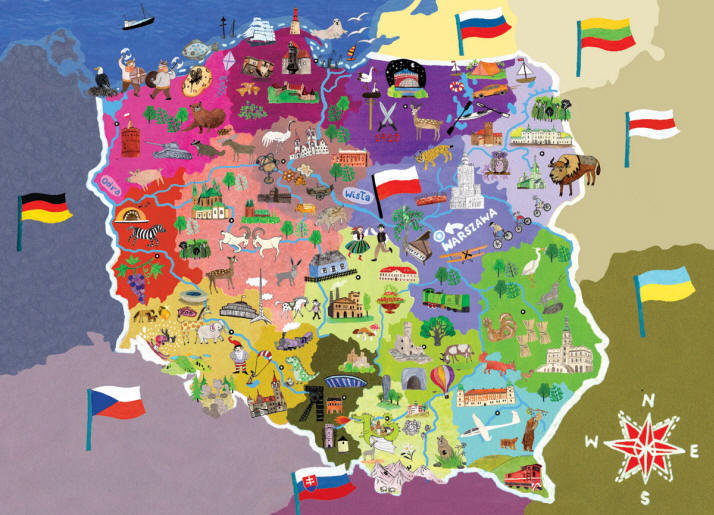
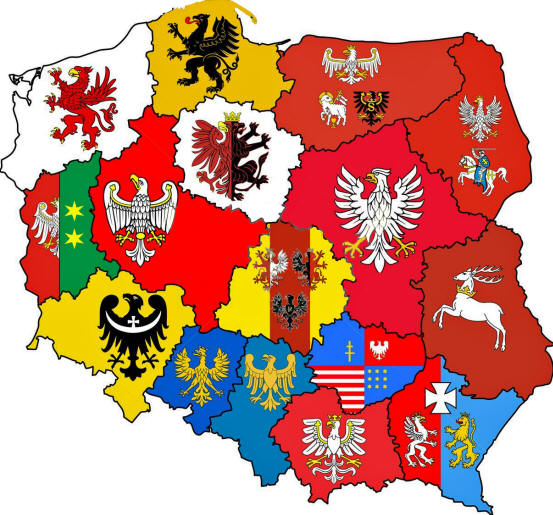
Here is a list of the 20 largest cities in Poland and their populations in 2013.
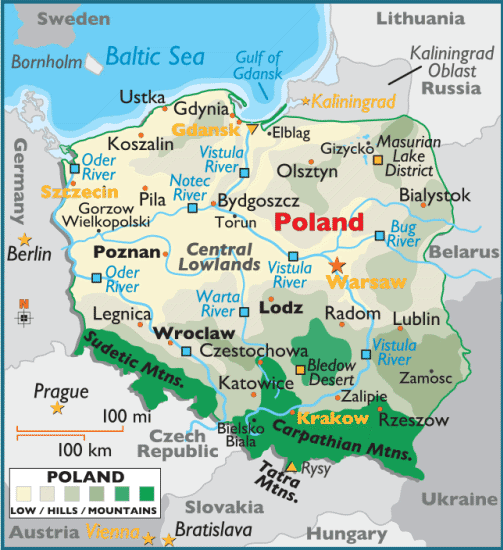
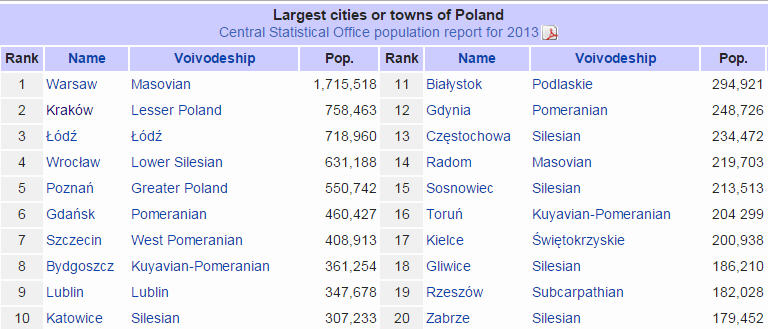
The city of Krak�w covers an area of 126.2 mi2 (326.8 Km2)
and the metro area is 395.06 mi2 (1,023.21 Km2.) It's population is 760,700 in the city
and 1,725,894 for the Metro
mi2 (1,023.21 Km2.) It's population is 760,700 in the city
and 1,725,894 for the Metro
 area.
8 million people live within 100 miles of the city center. It sits at an
elevation of 720 ft (220 m.) Krak�w (also spelled Cracow or Krakow) is the
second largest and one of the oldest cities in Poland. The city dates back
to the 7th Century and was the capital of Poland from 1038 to 1569. It
sits on the River Vistula (stock panorama above.) It's other flag is on
the left and the coat of arms of the city is on the right. It has sister
city connection to Cambridge, MA, Rochester, NY and San Francisco, CA as well as
many other world cities.
area.
8 million people live within 100 miles of the city center. It sits at an
elevation of 720 ft (220 m.) Krak�w (also spelled Cracow or Krakow) is the
second largest and one of the oldest cities in Poland. The city dates back
to the 7th Century and was the capital of Poland from 1038 to 1569. It
sits on the River Vistula (stock panorama above.) It's other flag is on
the left and the coat of arms of the city is on the right. It has sister
city connection to Cambridge, MA, Rochester, NY and San Francisco, CA as well as
many other world cities.
Below is a schema of the growth of the city from the center (red) in 1792 to its present size.
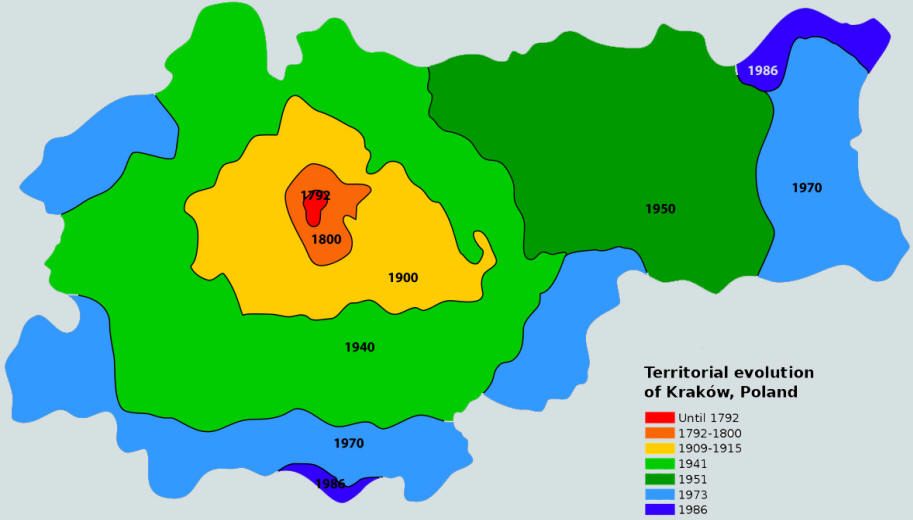
Like Paris, Krak�w is dived into 18 districts. We will primarily be seeing District I.

Below are Bing maps showing the central city encircled by highways (below left) and a close up of the Old Town where we are (below right.) You can see the Cloth Hall in the Main Square in the center.
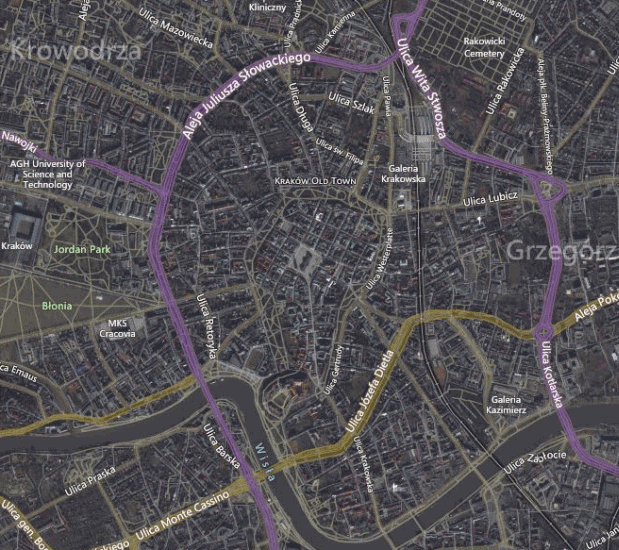
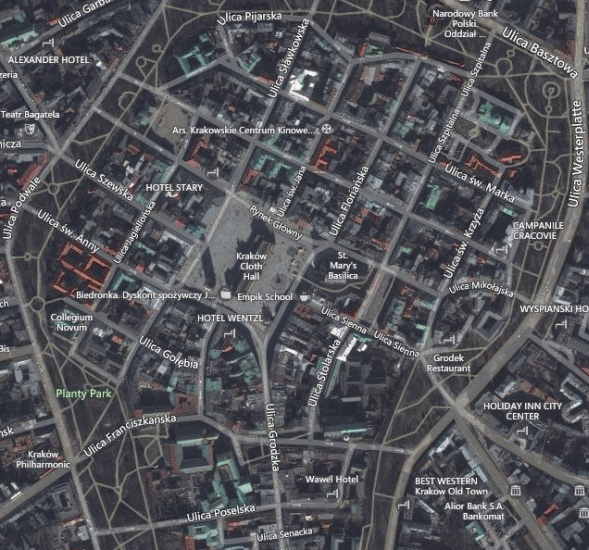
Here is a better map showing the trip we have to make from the our Hotel Santi down ulica Dominikaňska on to ulica Franciszkaňska, turn left one block and turn left again onto ulica Poselska to the Hungarian Balaton restaurant (where Marcia will have lunch,) then cross the pedestrian street ulica Grodzka and turn left again at the Wawel Hotel until reaching the gate of the parking lot.
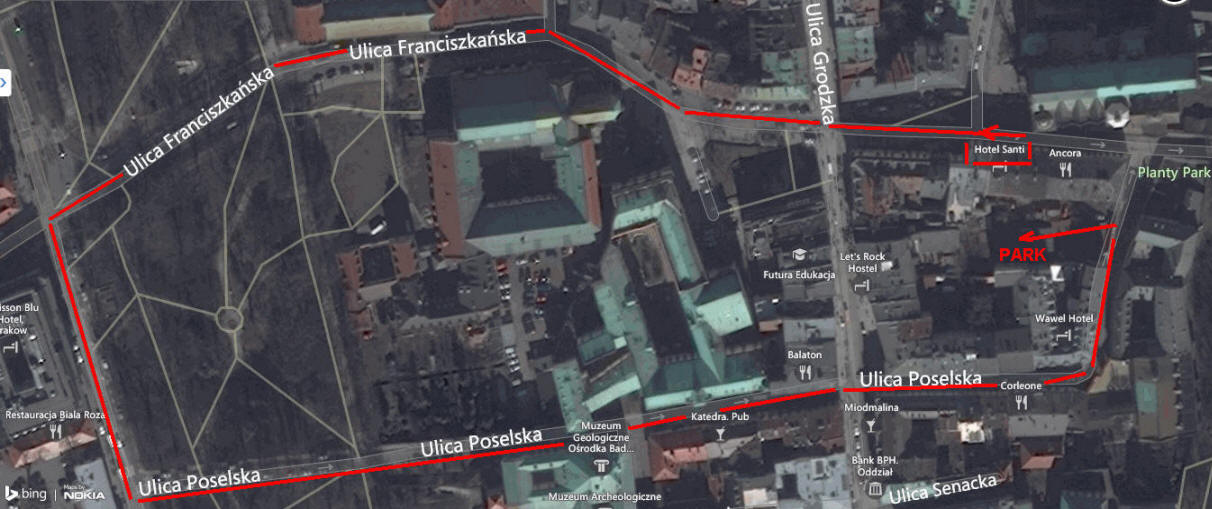
I woke at 3:50, 9:30 and 11:25 AM. I jumped into my running gear although I was hoping I might miss the rain. I used the GoPro camera to catch some photos of the modern interior of this beautiful little new hotel. On the left is the hallway leading to our room and on the right is outside our door.
They joined two buildings so they adjusted the different levels with these stairways.
If you don't use their modern elevator, these are the stairs.
e.jpg)
I got downstairs to the reception area (below left) at 2:00 PM and I talked to Luke and Katyrina about when we might see our refrigerator installed. They said they weren't sure but it should be soon. Everyone there was very nice.
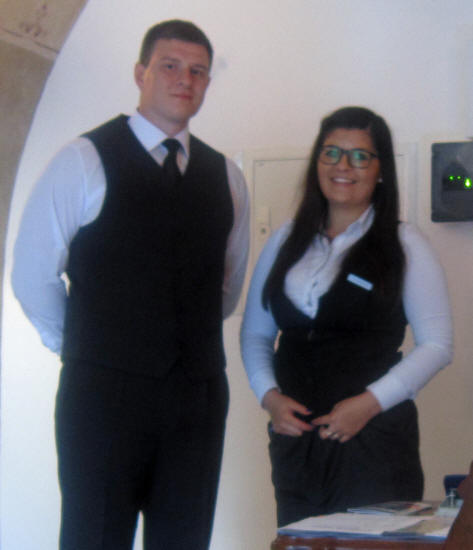
I went out front and got a definitive shot of the only sign that tells you this is the Hotel Santi (left.) I then went out back to where the car was parked to see that it was OK. The white truck is in front of the entry gate.
.jpg)
At 2:15 PM
I went directly next door to have a cappuccino at the
Beergallery [Dominikanska 3,
![]() +48-60-140-8870]
(below left) which cost me 5 zł ($1.42) which is pretty cheap. Matthew
(below right) took care of me and was very nice. It became obvious that this place
concentrates more on beer than its coffee drinks.
+48-60-140-8870]
(below left) which cost me 5 zł ($1.42) which is pretty cheap. Matthew
(below right) took care of me and was very nice. It became obvious that this place
concentrates more on beer than its coffee drinks.
It looks like it could hold a good number of people at night.
I sat in the front with a view of passersby. Note my small umbrella at the ready.
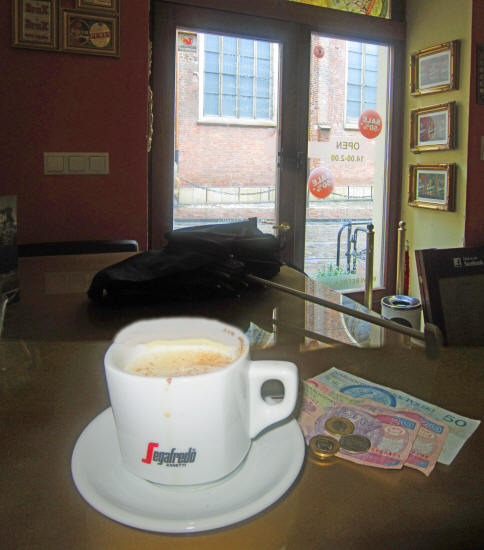
Here is the address sign for our hotel. As you can see I didn't time this cappuccino right, since now I will be running in the rain (below right: a rare Selfie so I can get the neighborhood in that fisheye mirror.)
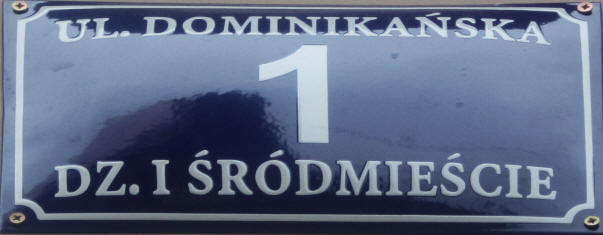
A block from my hotel is a beautiful park that is a 360� circle around the Stare Miasto (Old Town or inner city.) The park covers 52 acres (21,000 m2) and has a length of 2.5 miles (4 Km.) So at 2:40 PM, I began my run in the appropriately named Planty Park. Its a good thing I had put my rain gear on, it was really coming down.
This park (in green, map below left) replaced the medieval walls torn down between 1822�1830. Hotel Santi is marked in red (map.) I came across the Grażyna statue (stock photo, below center) which is in honor of an 1823 narrative poem by the famous poet, Adam Mickiewicz. The sign in the park (below right) directs you to all the important sites and how far away they are. It was conveniently also in English.
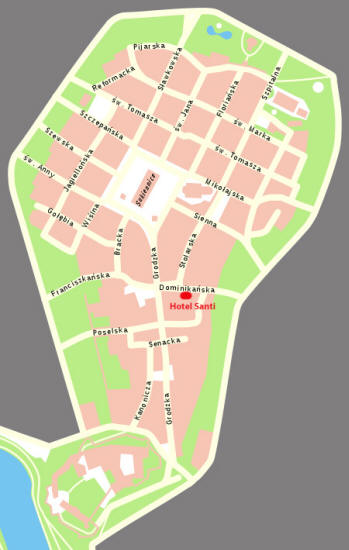
All the walls were torn down but they left two things; 1) The Brama Floriańska (St. Florian's Gate) (below left and center) and 2) the Barbakan (Barbican, built in 1498) (below right, from the days when the walls were up.)
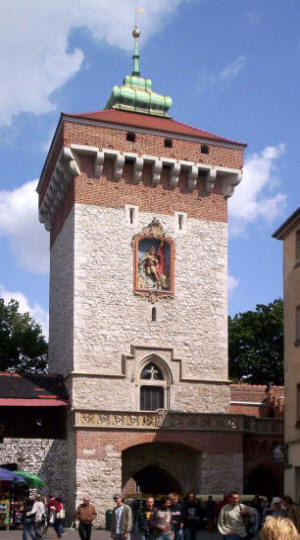
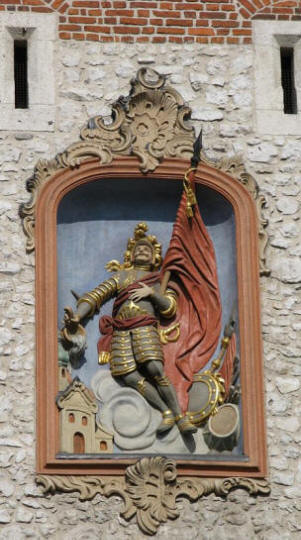
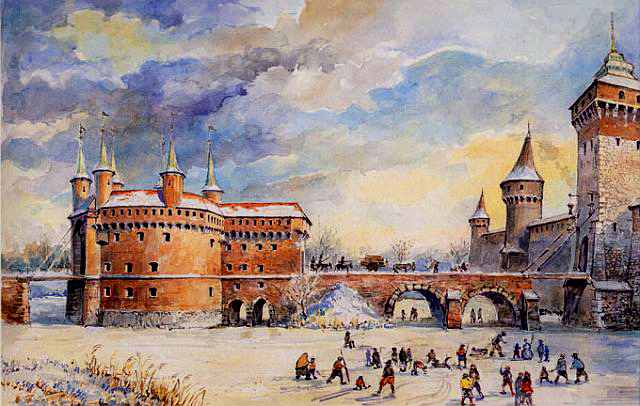
Here is a view of the Barbican from ulica Basztowej (street.) Today it is used for events.
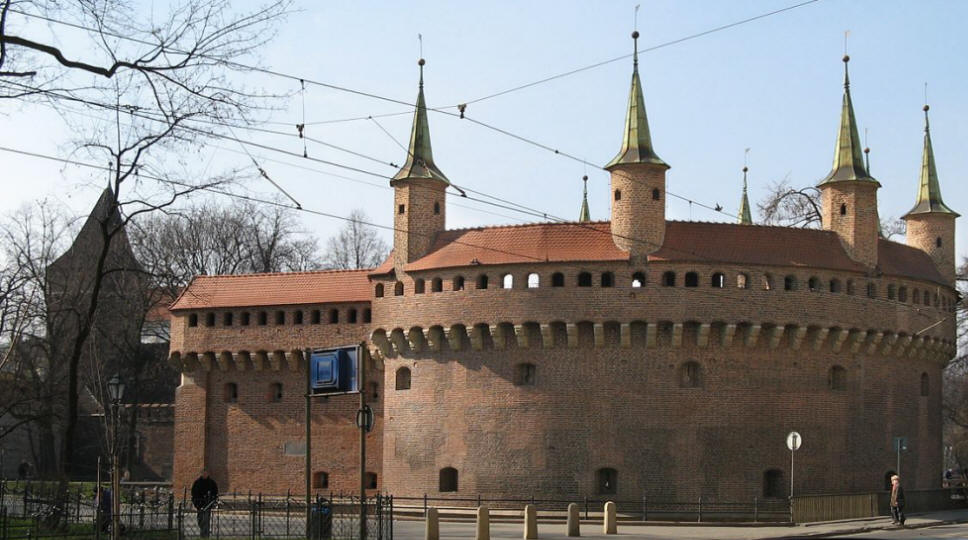
Below are stock photos from the front entry (left) and the rear exit (right.)
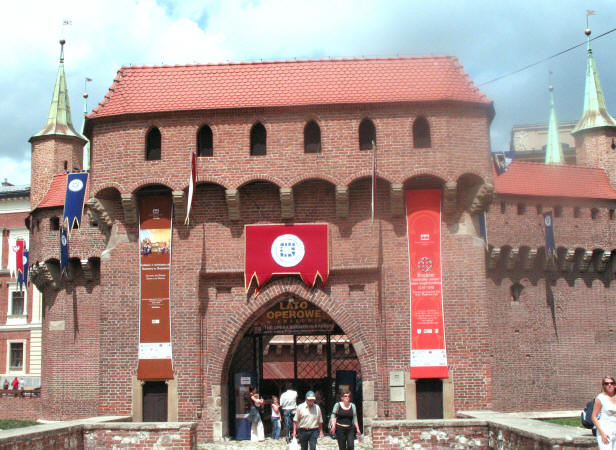
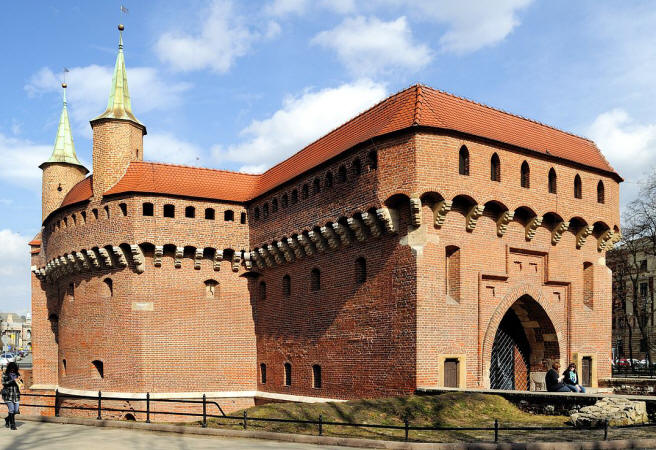
Below is a wide-angle stock photo of the interior courtyard where they can hold concerts.
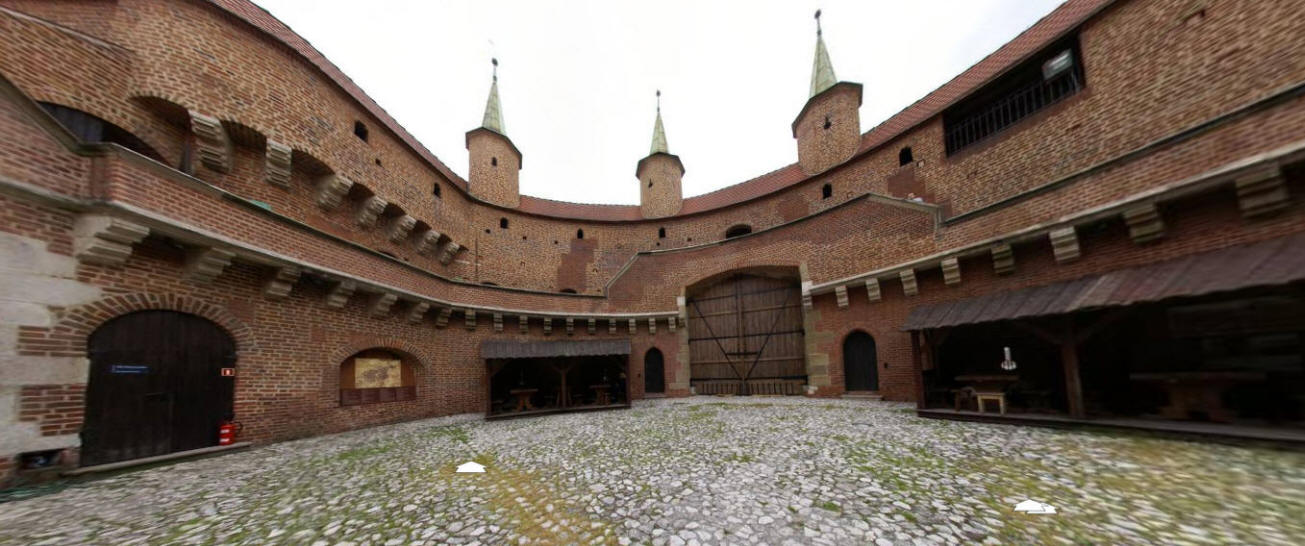
I had continued my run around the park (red line, map below) and then turned into the streets and at 3:10 PM I stopped in a currency exchange called Kantor Walut [Szczepa�ska 7] and changed a US$100 bill into 416 zł.
[Today (January 2015) 416 zł would be worth $118.]

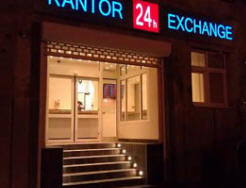

I then arrived in the center of the
Rynek Gł�wny (Main
Square) (aerial, below right,)
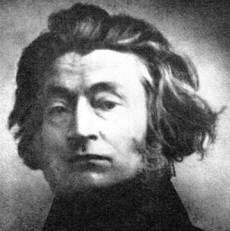 showing the
Cloth Hall (Sukiennice) building in the center,
the independent city tower behind it and the Adam
Mickiewicz Monument statue in the foreground.
Mickiewicz
(1798-1855, right at age 44) was the
greatest Polish Romantic poet of the 19th Century. [He was actually
Lithuanian.] The monument was
unveiled on June 16, 1898, on the 100th anniversary of his birth, in the
presence of his daughter and son. It was designed by
Teodor Rygier
(1841-1913.) During the occupation of Poland by Nazi Germany, the square
was renamed Adolf Hitler Platz and the Mickiewicz monument was destroyed along
with historical commemorative plaques taken from buildings on the square. After
the war the monument was reconstructed. This square, at almost 10 acres (40,000 m2,) is
the largest central city square in Europe. Below is a map of my run around
the Stare Miasto.
showing the
Cloth Hall (Sukiennice) building in the center,
the independent city tower behind it and the Adam
Mickiewicz Monument statue in the foreground.
Mickiewicz
(1798-1855, right at age 44) was the
greatest Polish Romantic poet of the 19th Century. [He was actually
Lithuanian.] The monument was
unveiled on June 16, 1898, on the 100th anniversary of his birth, in the
presence of his daughter and son. It was designed by
Teodor Rygier
(1841-1913.) During the occupation of Poland by Nazi Germany, the square
was renamed Adolf Hitler Platz and the Mickiewicz monument was destroyed along
with historical commemorative plaques taken from buildings on the square. After
the war the monument was reconstructed. This square, at almost 10 acres (40,000 m2,) is
the largest central city square in Europe. Below is a map of my run around
the Stare Miasto.
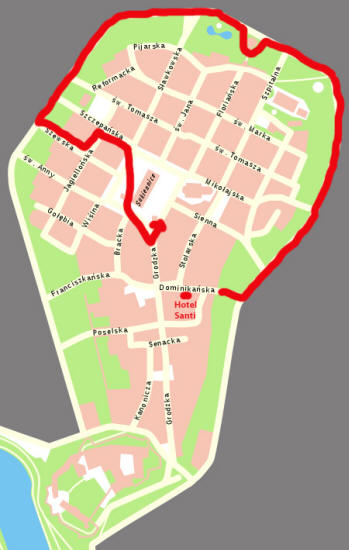
I finally arrived in the area of our restaurant last night and got a GoPro shot of the whole building (below left) and walked a bit further and took one of the Cloth Hall. It wasn't easy taking them while holding the umbrella and keeping dry.
Below is my PhotoStitch panorama of GoPro camera shots. Here you can see (L-R) the church, Cloth Hall and the City Tower.

Here is the same but from a different angle, further down the square. Ignore the bends.

Below is a very nice sunny day photo of it I found.
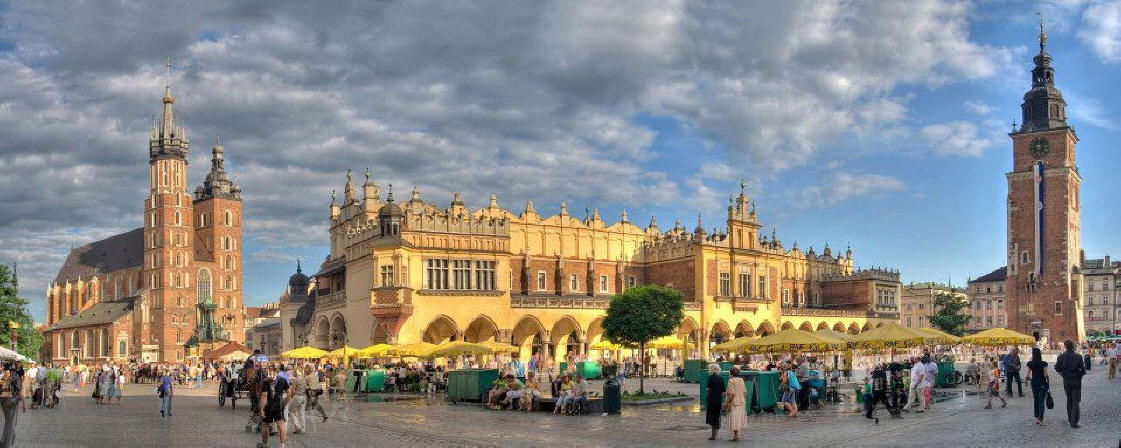
Since it was raining, it was a good idea to go into Cloth Hall and fast walk past all the many merchant kiosks.
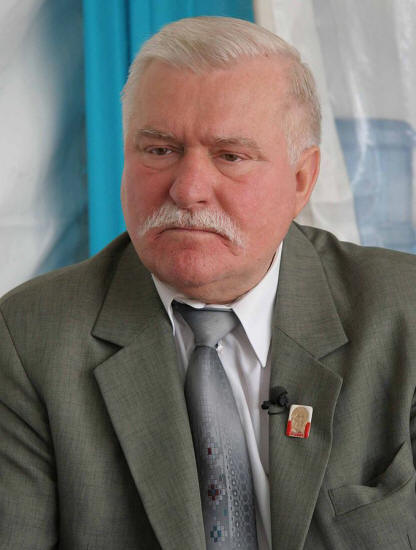
I left there and continued onto ulica Poselska and came across the Cracow headquarters for the famous Solidarity Union. This group changed the history of Poland and its leader Lech Wałęsa (above right) became the first President (1990-95) of the new free Poland. He still lives in Gdansk.

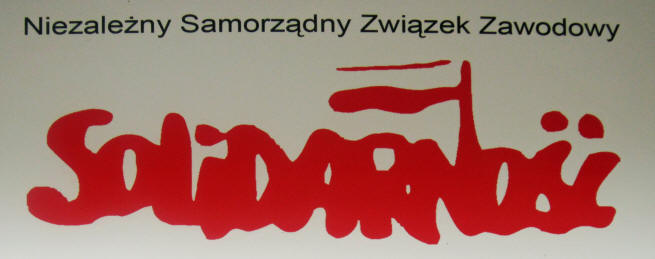
I started photographing some of the interesting architecture. Here is
a beautifully accented
building
(below left) with a memorial on the front (below right)
honoring Jan Matejko
(right) (1838-1893.) Click that last link to see his story and his
paintings (also below.) This building is called the
Palace of Art started in 1899 along the popular Planty Park by the Society
of Friends of Fine Arts. It was ceremonially inaugurated on May 11, 1901
becoming the first Art Nouveau building in the city, with Apollo's sculpted head
above its entrance.
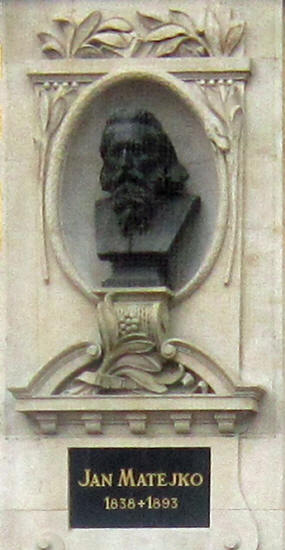
Matejko was a Polish painter known for his works of notable historical Polish political and military events. The Jan Matejko Academy of Fine Arts (below left,) or the Krak�w Academy of Fine Arts (Akademia Sztuk Pięknych w Krakowie im Jana Matejki) usually abbreviated to ASP is a public institution of higher learning. It is the oldest Polish fine arts academy, established in 1818, and granted full autonomy in 1873. Below right is Matejko's tomb in Cemetery Rakowicki in Krak�w. The cemetery is in the center of the city and has three interesting burial sites: ...
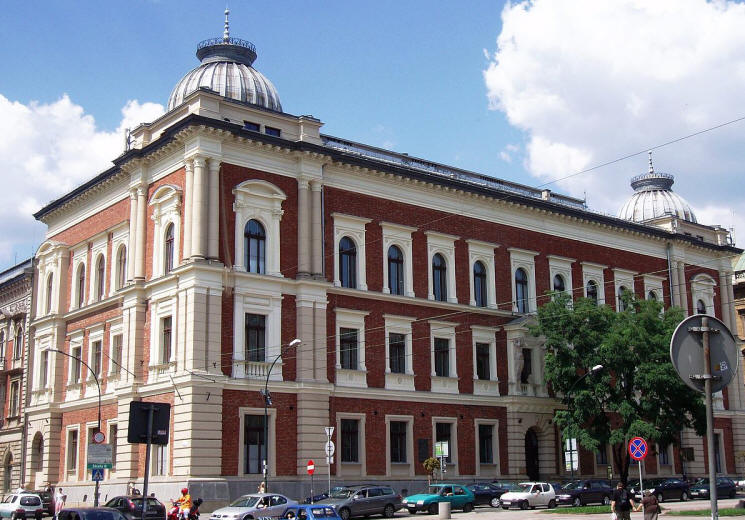
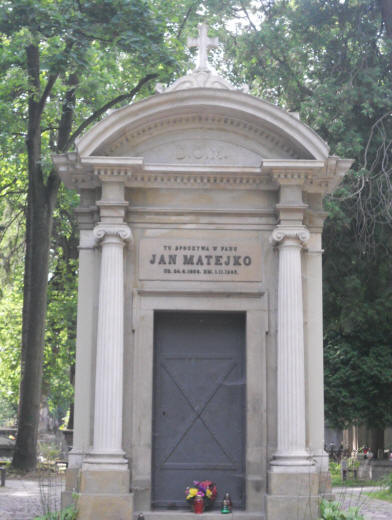
... 1) a memorial to the Russian soldiers who died here (below left,) 2) one for the German SS and Wermacht (center) and 3) one for the Allied Pilots who died over the city (below right.)
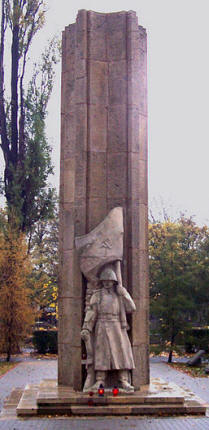
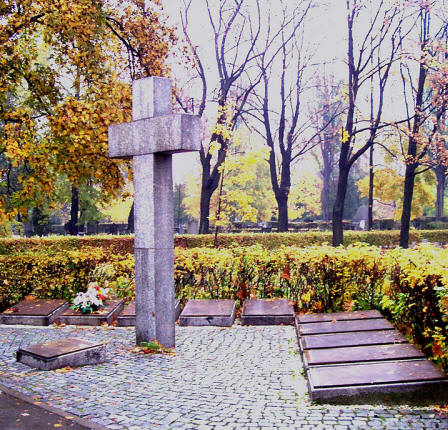
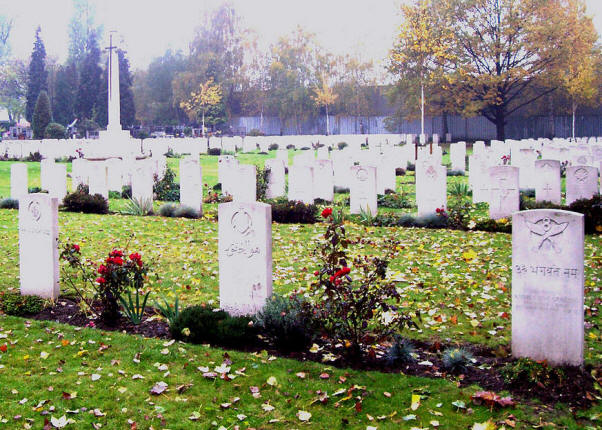
Getting back to Matejko, here are some examples of his huge historic epic art pieces. Below left is "Rok 1863", the woman representing Poland being chained by the Russians for expulsion to Siberia. Below right is the "Reception of the Jews in 1096."
This one is entitled "Prussian Homage."
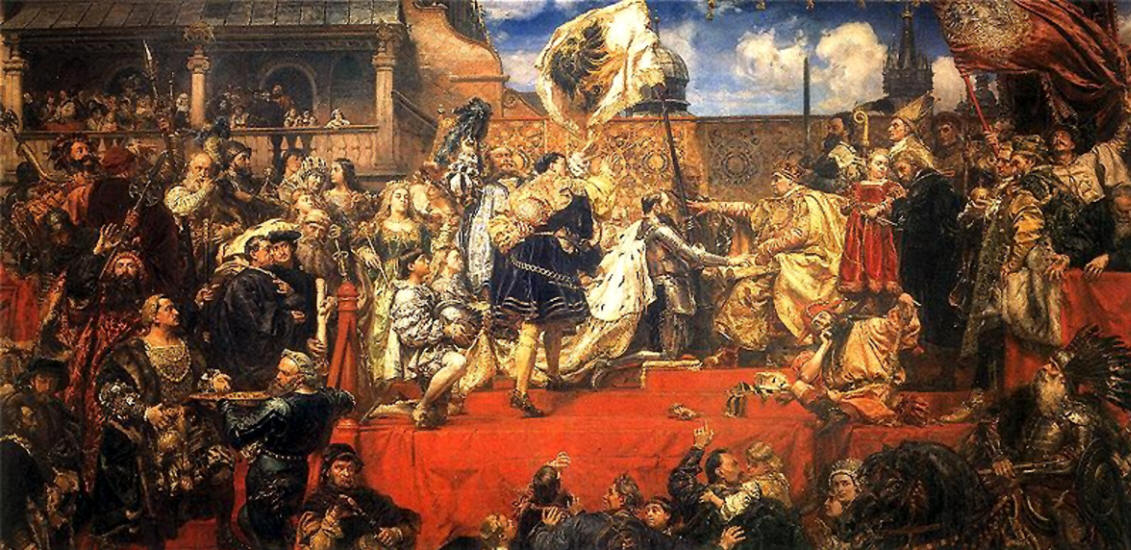
This one is the signing of the Constitution. You can see why he was so highly regarded.
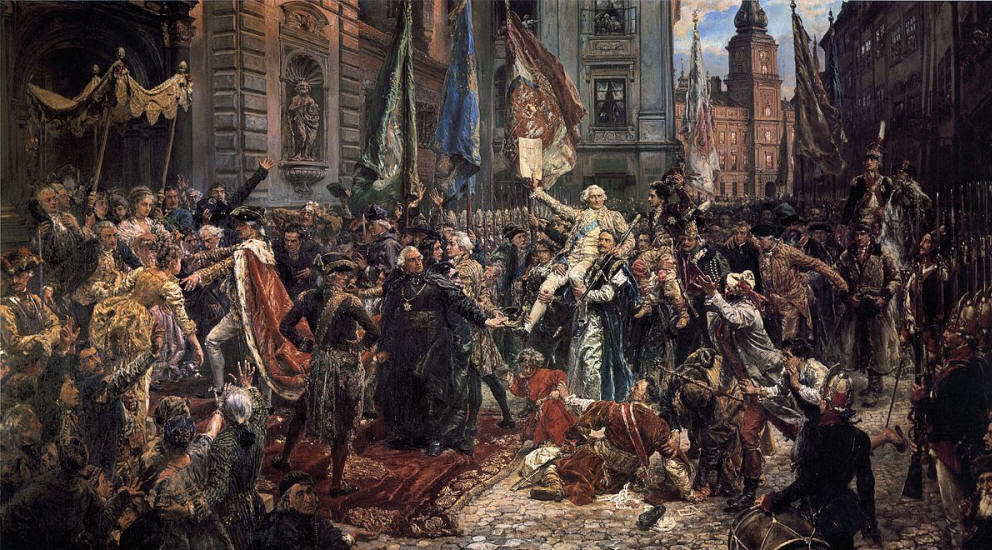
As I continued walking, I then found these buildings on ulica Szczepanska. This one was labeled as Towarzystwo Muzycznl Konserwatoryum (Music Society Conservatory) which is home to the Old Theatre (Teatr Stare.) Below right is the name plaque on the building under the central upper double window.
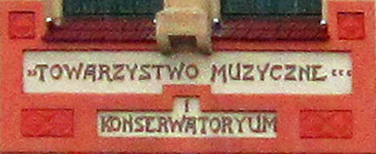
Below is a very nice artistic photo of it I found.
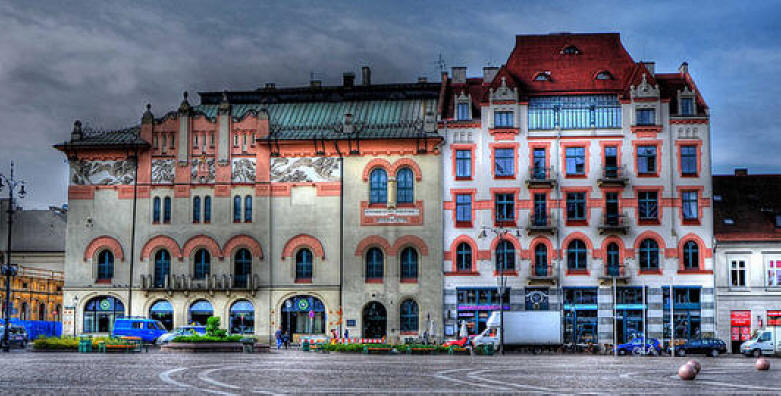
This building (below) was also quite nice. There is a relief statue at the top of each of the gray columns. I made a collage of them so they can be seen.

In many places they have these large maps of the city posted. You can see the Old Town (Stare Miasto) surrounded by Planty Park and the outer lying area of the city such as Kleparz in the north, Grzeg�rki to the east and Kazimierz to the south (the old Jewish section.) We will wind up driving to Kazimierz tomorrow night for dinner. You can see the railway station in the north (large brown rectangle.)
.jpg)
.jpg)
Here is a stock photo of the Krak�w Train Station (Gł�wny) [Gwov-knee] built in 1844.
I then went by the other side of the Old Theater (1841) building (the entrance) that had memorial plaques on it honoring famous people of the theater.
They are to Wiktor Sadecki (1923-1987) (below left) and Jerzy Binczycki (1937-1998) (below right) who were both very famous Polish actors.
.jpg)
.jpg)
Konrad Swinarski (1929-1975) (below left) was a Polish theater director, television, film and opera director, producer and production designer. Wladyslawowi Zelenskiemu (center) I can't find. Here is a nice stock photo of the theater entrance (below right.)
.jpg)
.jpg)
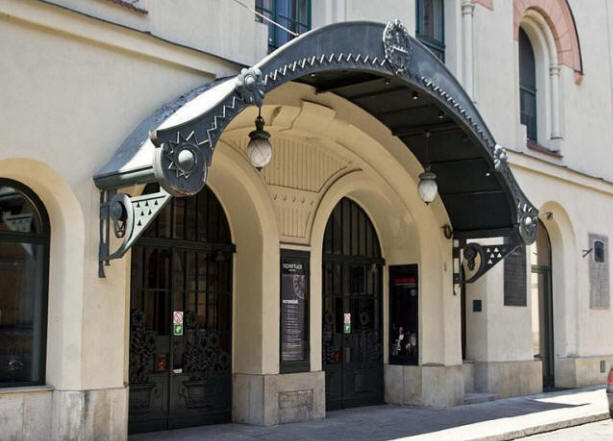
Below are shots of these plaques that I found on the interenet.
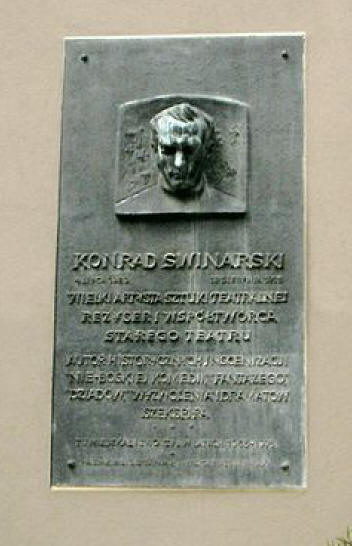
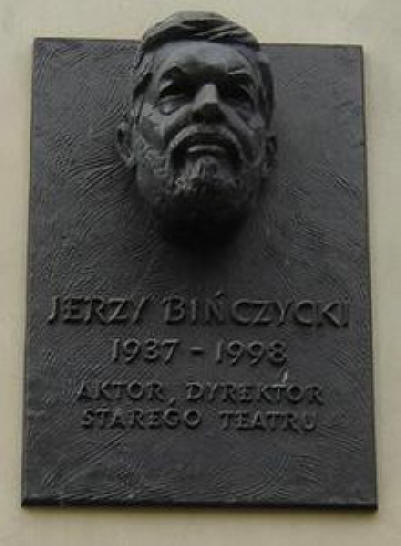
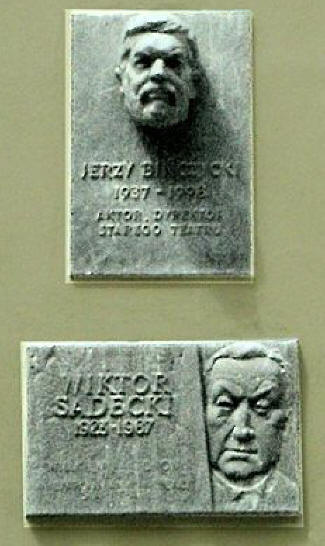
I then walked by the
Caffe Zacmienie [Szczepańska 3,
![]() +48-12-431-1827] which
had a very nice outdoor patio.
+48-12-431-1827] which
had a very nice outdoor patio.
I continued onto Sławkowska [Swav-cow-ska] ulica and came across a Subway store (below right.) They are everywhere.

Then I came upon this church at the corner of ulica SW. Marka
 and
ulica Sławkowska with an elaborate crucifix on the side of the building.
St. Mark�s Church (below) is a picturesque Gothic structure from the early
14th Century with a late Renaissance interior. It was closed so I found
this stock photo of the altar (below right.) It has a Gothic crucifix in
the altarpiece and a pulpit in the shape of a heart. The exterior statuary
(center) are modern copies of the 1500 originals which were transferred to the
interior.
and
ulica Sławkowska with an elaborate crucifix on the side of the building.
St. Mark�s Church (below) is a picturesque Gothic structure from the early
14th Century with a late Renaissance interior. It was closed so I found
this stock photo of the altar (below right.) It has a Gothic crucifix in
the altarpiece and a pulpit in the shape of a heart. The exterior statuary
(center) are modern copies of the 1500 originals which were transferred to the
interior.
.jpg)
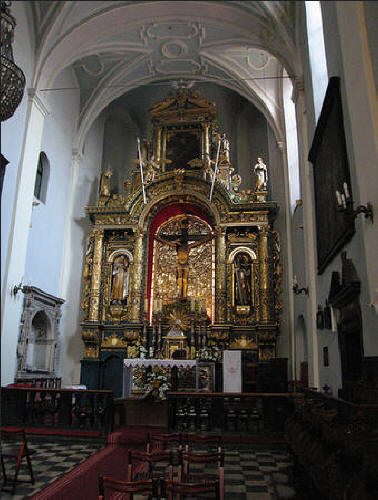
Then I took these photos of a shop displaying all these Polish dishes and ceramics.
There were many shapes and patterns available. Here is another shot of the rainy plaza looking towards the Fine Arts building.
.jpg)
At 3:15 PM  I
was finally ready to sit down and have a
cappuccino and get a chance to
get out of the rain and dry off. I decided to see if I could get one at the 5-Star Grand Hotel
(�180/night) [ulica Sławkowska 5/7,
I
was finally ready to sit down and have a
cappuccino and get a chance to
get out of the rain and dry off. I decided to see if I could get one at the 5-Star Grand Hotel
(�180/night) [ulica Sławkowska 5/7,
![]() +48-12-424-0800 or +48-12-421-7255.] Below are some stock photos of this
grand old place from their website.
+48-12-424-0800 or +48-12-421-7255.] Below are some stock photos of this
grand old place from their website.
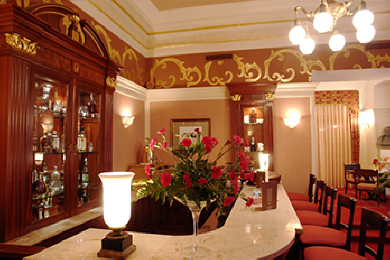
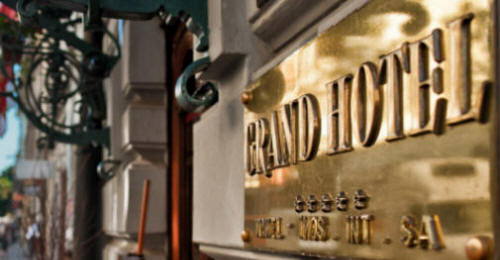
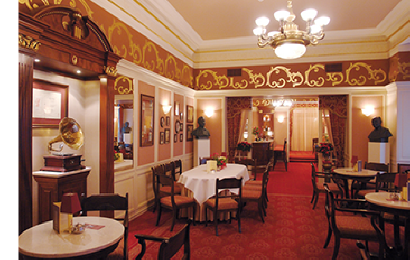
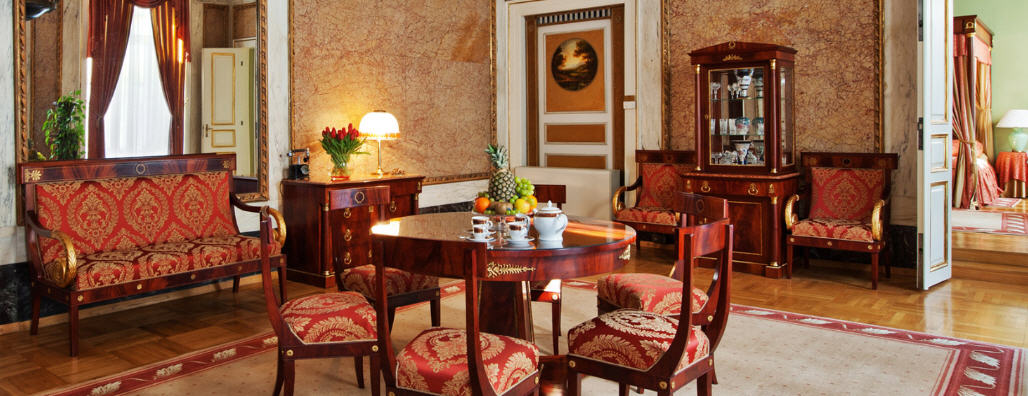
Here is the exterior of the hotel and the interior dining room.
Ewelina (below) was behind the bar and she took good care of me. The cappuccino cost me 14 zł. Jimi, the bellman was a very friendly character. Seems like a nice place to stay, if not a little pricey. It's right off the Main Square.
While I was there, at 3:20 PM,
Marcia had lunch at the Hard Rock Cafe [Plac Mariacki 9,
![]() +48-12-429-1155] in the Main Square and had a hamburger and a Pepsi-lite for 57 zł.
After relaxing a little, I left the Grand Hotel and at 4:00 PM
I bought a pin at
Krakow
Souvenirs [ulica Grodzka 13] for 10 zł. At 4:15 PM
I purchased two Orange Polish SIM phone chips at a box built into the side of a
building called Handlowa [ulica Bursztynowa 1/28.] They cost me 5 zł
each which is not bad. My Polish number is now
+48-51-662-2521 and Marcia's is +48-51-662-2539. I then headed back to our
hotel.
+48-12-429-1155] in the Main Square and had a hamburger and a Pepsi-lite for 57 zł.
After relaxing a little, I left the Grand Hotel and at 4:00 PM
I bought a pin at
Krakow
Souvenirs [ulica Grodzka 13] for 10 zł. At 4:15 PM
I purchased two Orange Polish SIM phone chips at a box built into the side of a
building called Handlowa [ulica Bursztynowa 1/28.] They cost me 5 zł
each which is not bad. My Polish number is now
+48-51-662-2521 and Marcia's is +48-51-662-2539. I then headed back to our
hotel.
Since we only have two full days here in Krak�w and there are two things we definitely have to see, I was determined to see one of them today. So today I had planned on seeing the Salt Mine but Marcia said she thought she was coming down with a cold and it was going to be too cold and rainy to go down into a underground mine. So if I wanted to see it, I was going to have to go it alone. So I dressed really warmly and at 5:00 PM got the car from the lot and put the GPS on the Wieliczka Salt Mine and started the 6.5 mile (11 Km) drive in very bad rush hour traffic. Several times I almost gave up since the last entry time was rapidly approaching. Since we had to see the other site (Auschwitz) tomorrow I persisted just in case I had a chance and lucky for me I arrived just in time for the very last entry.
I arrived to park at 5:30 PM which means the 6 mile drive took 30 minutes. I found a place to park which cost me 15 zł.
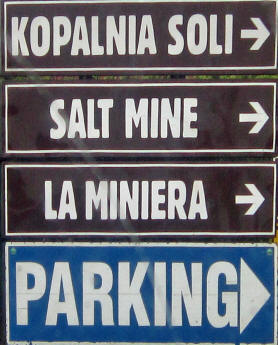
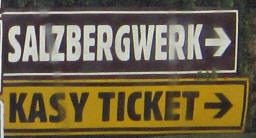
The man in the lot directed me to the main entry building. The mine is on the UNESCO list of World Heritage sites. Since I was in such a hurry, I forgot to take any pictures so I found these photos of the front of the building. I really wasn't sure if I had missed the last English tour.
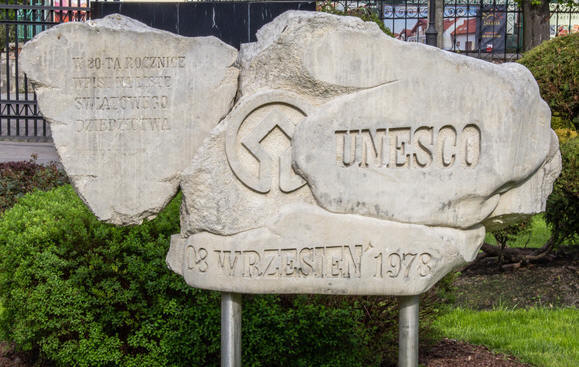
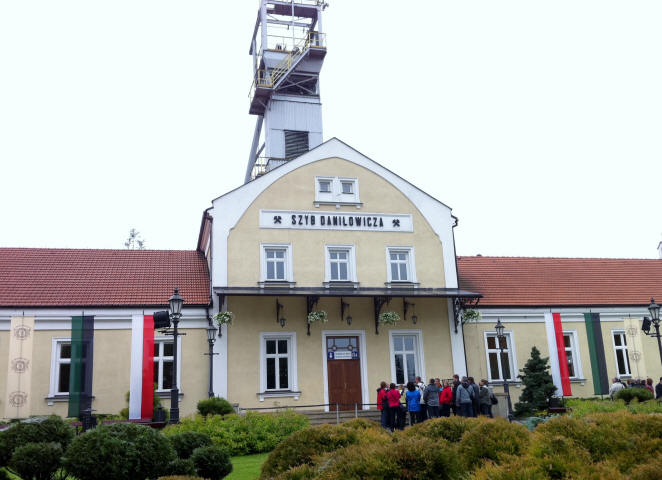
At 5:35 PM
I entered the building
of the Kopalnia Soli
Wieliczka Salt Mine
[Daniłowicza 10, Wieliczka,
![]() +48-12-278�7302,
www.kopalnia.pl, Open Apr�Oct: daily 7:30�7:30] and went up to the Kasa line
(below left) and very lucky for me, I was able to get the very last tour.
The entry ticket (below right) cost me 75 zł and they let you pay an
additional 10 zł for photographing, which I was very happy to pay.
+48-12-278�7302,
www.kopalnia.pl, Open Apr�Oct: daily 7:30�7:30] and went up to the Kasa line
(below left) and very lucky for me, I was able to get the very last tour.
The entry ticket (below right) cost me 75 zł and they let you pay an
additional 10 zł for photographing, which I was very happy to pay.
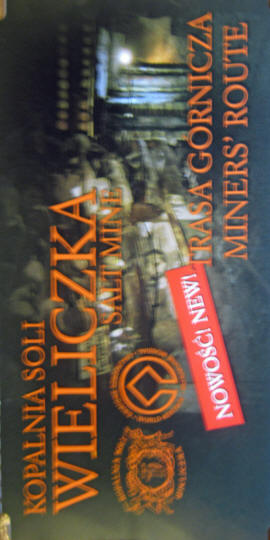
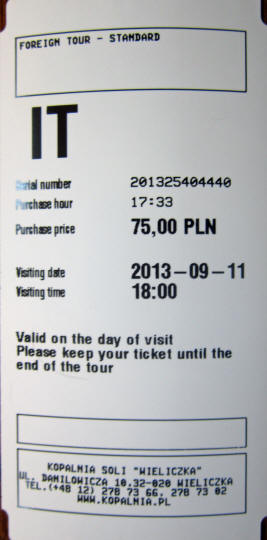
Below left is a blurry shot of my badge sticker that allows me to take pictures and video. I needed to use the restroom and discovered what you say in Polish for Push (Ciągnąć) and Pull (Pchać.) I also learned tht "bezpłatna" means "free."
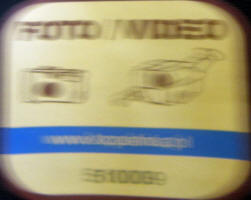
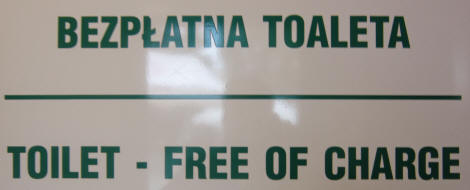
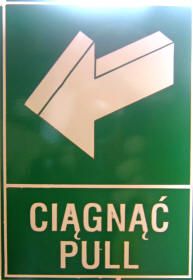
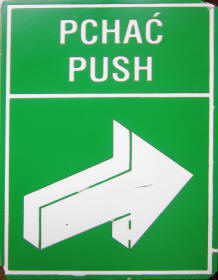
I felt very lucky to get in this line to wait for entry.
Their symbol was on the wall of the entry and on the floor inside.
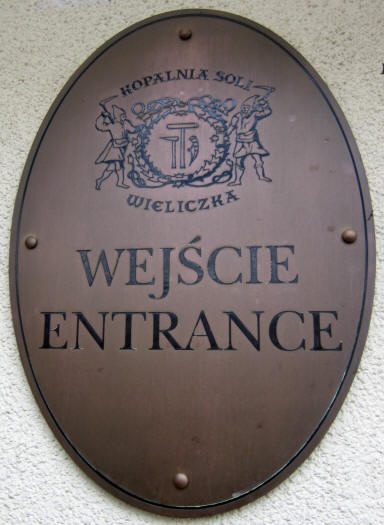
While I was there, Marcia was in the Main Square and at 5:40 PM
she bought an umbrella and postcards at Cracovia Souvenirs [ulica Krakusa 20,
![]() +48-50-221-8248] for 61 zł ($20.) She then went for more shopping at Marszałkowska [Pawia 5,
+48-50-221-8248] for 61 zł ($20.) She then went for more shopping at Marszałkowska [Pawia 5,
![]() +48-22-451 -0385.]
Finally, at 6:00 PM, our guide, Goma (below with her compatriot,) joins us and
leads us to the stairs down into the mine.
+48-22-451 -0385.]
Finally, at 6:00 PM, our guide, Goma (below with her compatriot,) joins us and
leads us to the stairs down into the mine.
.jpg)
.jpg)
 We
had to climb down 800 steps of the Daniłowicz Shaft (szyb) to a depth of 443 ft (135 m) which took a full
nine minutes to get to the bottom. On the left you can see the shaft to
the left of the handrail. On the right you can see all the way to the
bottom.
We
had to climb down 800 steps of the Daniłowicz Shaft (szyb) to a depth of 443 ft (135 m) which took a full
nine minutes to get to the bottom. On the left you can see the shaft to
the left of the handrail. On the right you can see all the way to the
bottom.
.jpg)
.jpg)
The little black rectangle in the center is the bottom. This was a really long walk down.
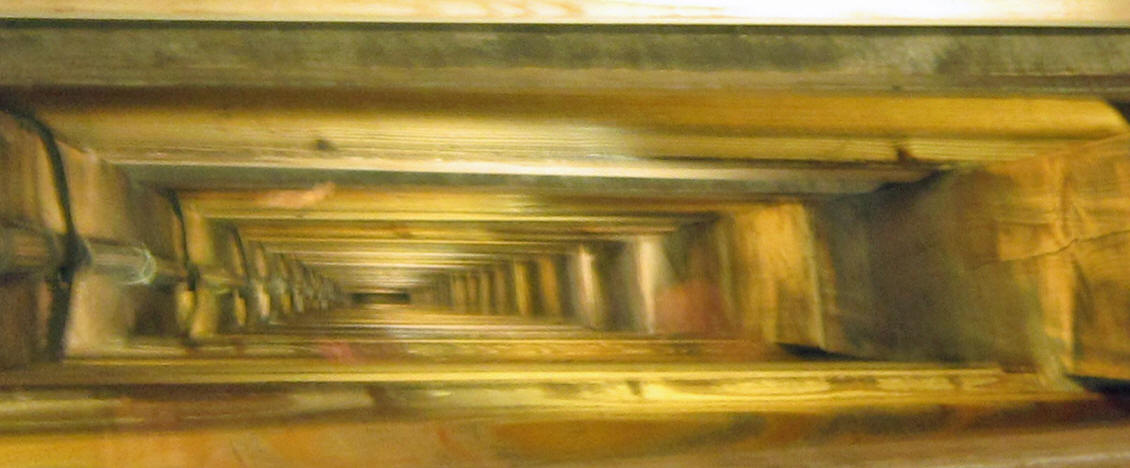
From here she leads us into this room called the Upper (gorna) Urszula Chamber
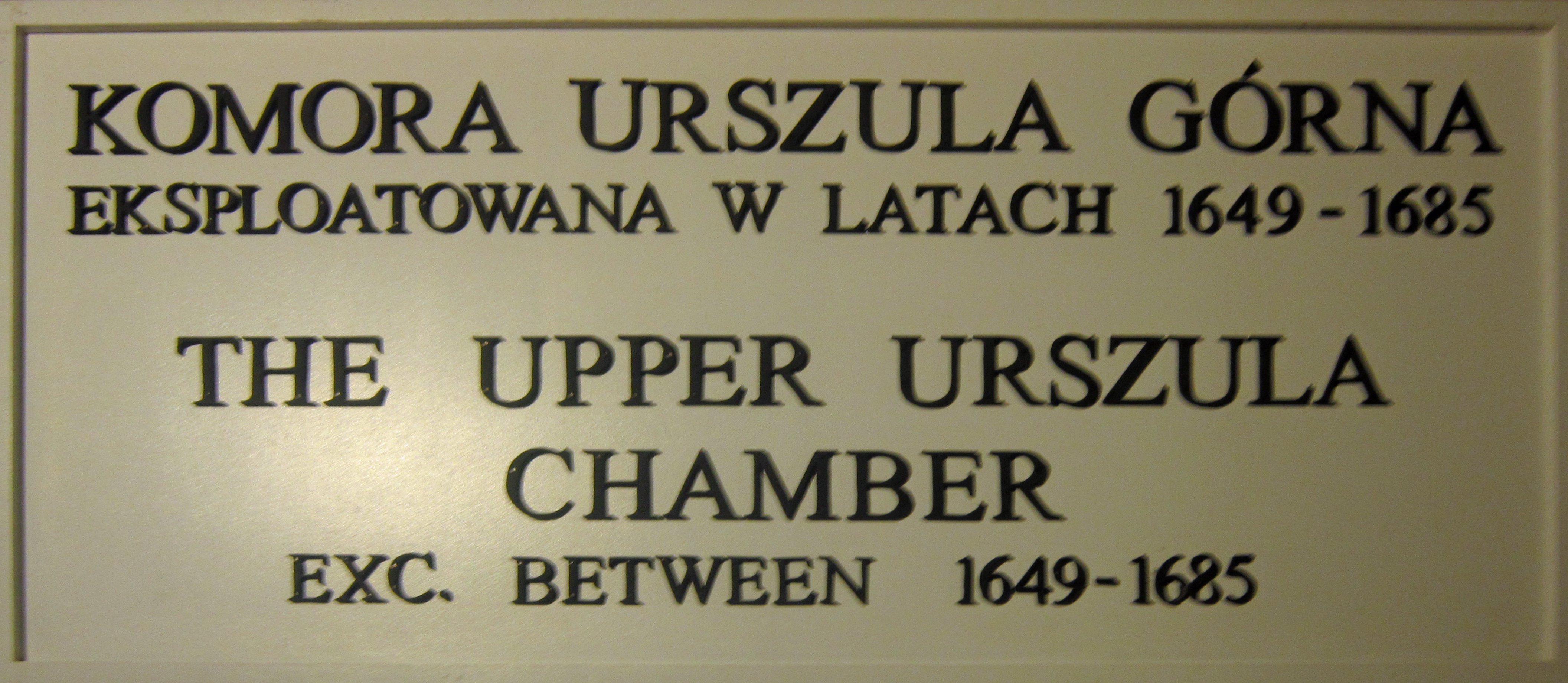 (1649-1685)
which demonstrates some of the methods they used to mine the salt. "The
historic Salt Mine in Wieliczka is the only site in the world where mining has
continued since the Middle Ages. Lying on nine levels, its original
excavations (longitudinals, traverses, chambers, lakes, as well as lesser and
major shafts) stretch for the total of 186 miles (300 Km:) reaching the depth of
1073 ft (327 m) they illustrate all the stages of the development of mining
technology over time."
(1649-1685)
which demonstrates some of the methods they used to mine the salt. "The
historic Salt Mine in Wieliczka is the only site in the world where mining has
continued since the Middle Ages. Lying on nine levels, its original
excavations (longitudinals, traverses, chambers, lakes, as well as lesser and
major shafts) stretch for the total of 186 miles (300 Km:) reaching the depth of
1073 ft (327 m) they illustrate all the stages of the development of mining
technology over time."
e.jpg)
e.jpg)
They had dummies set up to illustrate various mining techniques throughout the ages. They weren't bad but not the quality of Disneyland.
e.jpg)
.jpg)
We were then guided to walk through these various tunnels. I stayed back to get an unoccupied photo of them.
.jpg)
e.jpg)
They certainly looked solid.
e.jpg)
.jpg)
Then we entered a room called Komora [Chamber] Urszula (1938.) Urszula chamber is at Level I, at a depth of 210 ft (64 m.) It was dug in the upper part of the large body of green salt. The miners began their work around here in 1649, bringing salt up by hand.
e.jpg)
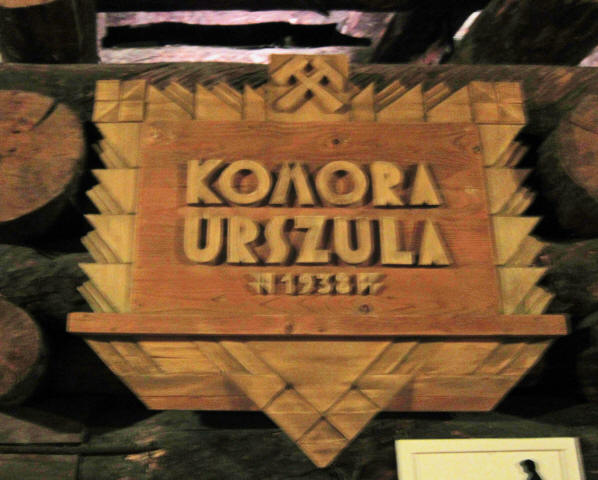
Below left is a stock photo of the chamber. On the right is the next passageway.
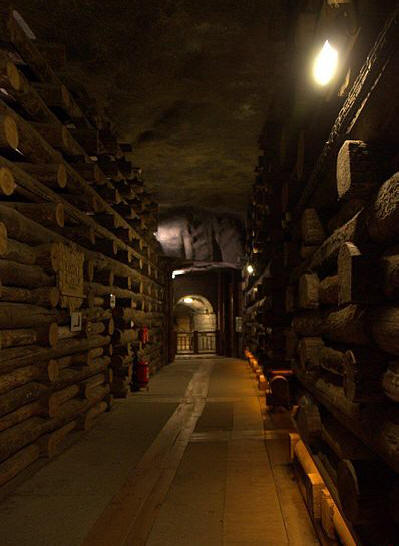
e.jpg)
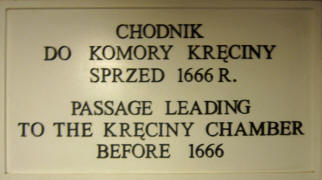
This finally led us to areas where we could see the walls (below right.) I expected it to be solid white like salt but it was gray and black.
.jpg)
e.jpg)
I got some close up shots of the wall so you can see the salt a little better.
.jpg)
.jpg)
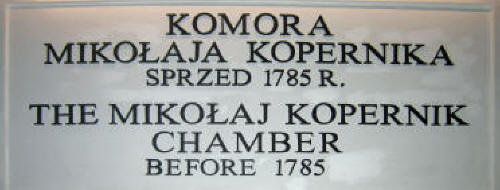
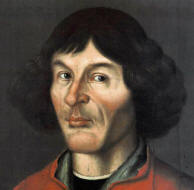
We then entered the Komora Mikołaja Kopernika (pre-1785) which is the Nicolaus Copernicus (1473�1543, above right) Chamber. He was a physician, mathematician and astronomer who stated that the Sun was the center of the Universe, not the earth. A statue of him was created by Władysław Hapek in 1973, commemorating the 500th anniversary of the birth of the astronomer. He actually visited these salt mines. On the left is a GoPro shot of the chamber and on the right a Canon flash shot of the statue (in salt.)
e.jpg)
.jpg)
Goethe and Copernicus had visited the Wieliczka mine (even though most of what they visited is actually out of bounds due to safety restrictions). The present Individual Tourist Route represents only around 1% of the Wieliczka salt mine! This is pretty impressive considering that its a 3 hour tour along a 2 Km trail which takes you down to a depth of 150 meters.
We then entered the Janowice Chamber (Komora Janowice) (pre 1642) which displays
salt statues of the legend of the miners finding the ring of St. Kinga in the
mine. Kinga is also called Cunegunda, Kunigunda, Kunegunda, Cunegundes,
Kioga, Zinga; Polish: Święta Kinga, Hungarian: Szent Kinga. Kinga
(1224�1292) is a saint in the Catholic Church and patroness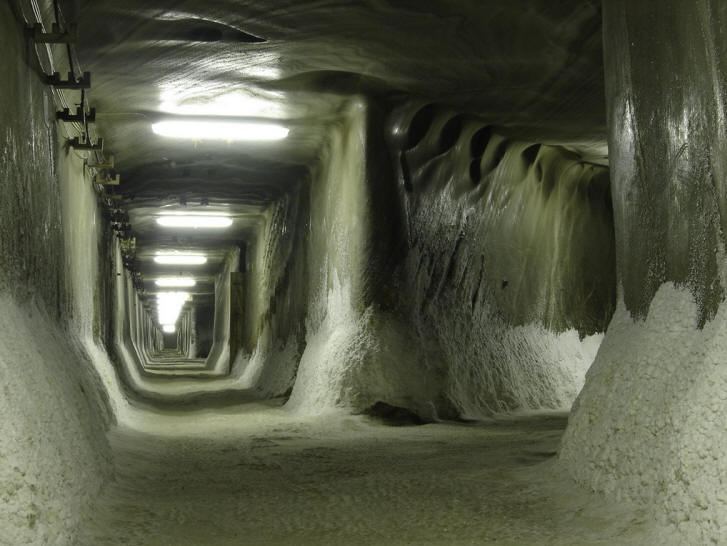 of Poland and Lithuania. She was born in Esztergom, Hungary, the daughter
of King B�la IV of Hungary and was a niece of St. Elizabeth of Hungary.
She reluctantly married Bolesław V ("the Chaste") of Krakow. She became princess
when her husband ascended the throne as Prince of Cracow. Despite the
marriage, the devout couple took up a vow of chastity. During her reign,
Kinga got involved in charitable works such as visiting the poor and helping the
lepers. When her husband died in 1279, she sold all her material
possessions and gave the money to the poor. She soon did not want any part
in governing the kingdom which was left to her and decided to join the Poor
Clares monastery at Sandec (Stare Sącz.) She would spend the rest of her
life in contemplative prayer and did not allow anyone to refer to her past role
as Grand Duchess of Poland. She died on July 24, 1292, at age 68.
Pope Alexander VIII beatified Kinga in 1690. In 1695, she was made
of Poland and Lithuania. She was born in Esztergom, Hungary, the daughter
of King B�la IV of Hungary and was a niece of St. Elizabeth of Hungary.
She reluctantly married Bolesław V ("the Chaste") of Krakow. She became princess
when her husband ascended the throne as Prince of Cracow. Despite the
marriage, the devout couple took up a vow of chastity. During her reign,
Kinga got involved in charitable works such as visiting the poor and helping the
lepers. When her husband died in 1279, she sold all her material
possessions and gave the money to the poor. She soon did not want any part
in governing the kingdom which was left to her and decided to join the Poor
Clares monastery at Sandec (Stare Sącz.) She would spend the rest of her
life in contemplative prayer and did not allow anyone to refer to her past role
as Grand Duchess of Poland. She died on July 24, 1292, at age 68.
Pope Alexander VIII beatified Kinga in 1690. In 1695, she was made
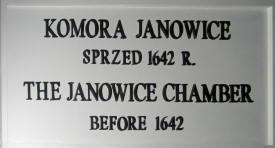 chief
patroness of Poland and Lithuania. On June 16, 1999, she was, of course,
canonized by Pope John Paul II.
chief
patroness of Poland and Lithuania. On June 16, 1999, she was, of course,
canonized by Pope John Paul II.
Now the legend. The story has Kinga throwing her engagement ring into the Maramures salt mine in Hungary (stock photo, above right.) Here the salt is much whiter on the walls. The ring miraculously traveled along with salt deposits to Wieliczka where it was rediscovered by a miner. This statuary depicts the historic legend. The first are the GoPro shots of it.
e.jpg)
e.jpg)
Here are the Canon shots after editing to lighten them.
.jpg)
.jpg)
.jpg)
.jpg)
Here is a wider shot of the scene that I found.
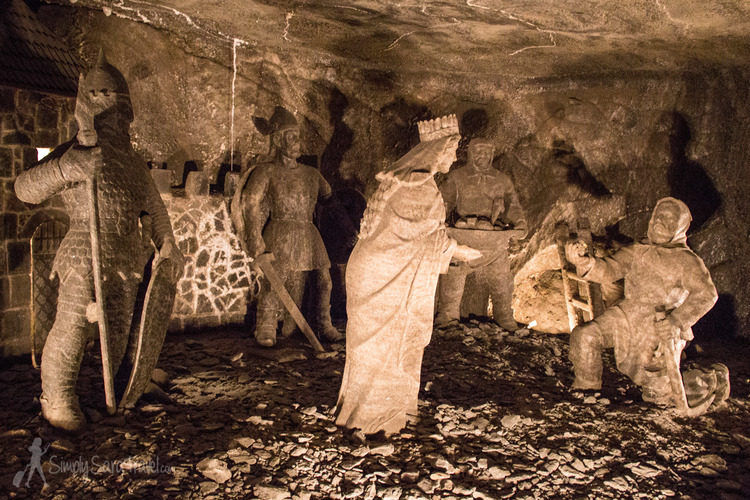
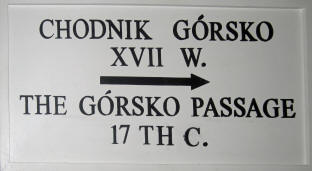
From here we enter the 17th Century G�rska Passage (chodnik.) Below is an example of where the salt appears white (below left) and a miner with a torch (below right.)
.jpg)
.jpg)
Here is a much better photo that I found.
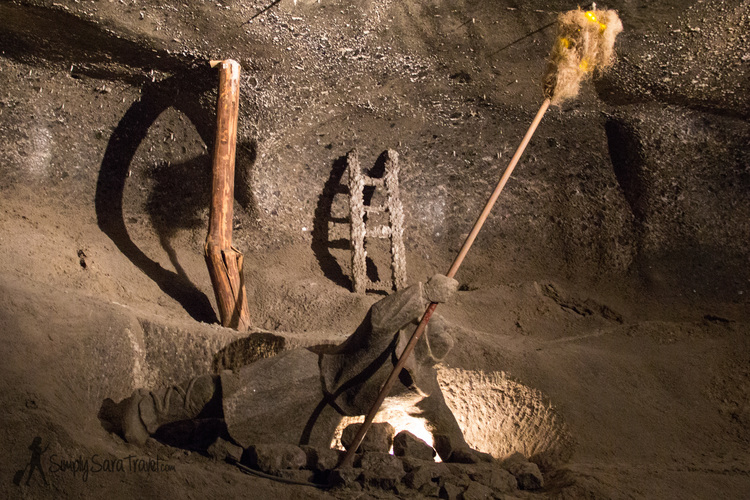
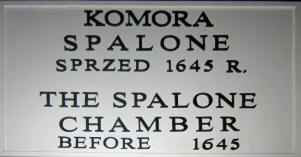
Then we entered the Spalone Chamber, also from the 1600s. Here there are many figures set up showing how the miners worked in those days.
.jpg)
.jpg)
e.jpg)
e.jpg)
.jpg)
.jpg)
The next room was called the Casimir the Great Chamber. It was quite a huge room. I got these shots of the salt-dripping down from the ceiling like sharp spikes.
e.jpg)
.jpg)
Here they had this large mill structure showing the horses that used to turn it.
e.jpg)
.jpg)
Then we entered an area with several dioramas of what life was like in these "Neolithic Saline Works 6,000 years ago."
e.jpg)
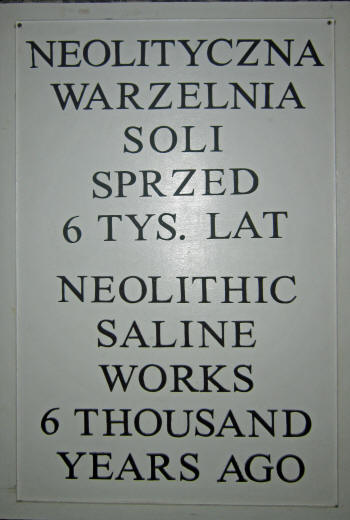
They also had a model of a structure (with and without flash.)
.jpg)
.jpg)
This plaque translates to "In tribute to the creators of the Statute of the Krakow salt mines 600th Anniversary in these chambers named after King Casimir the Great, 1368-1968."
.jpg)
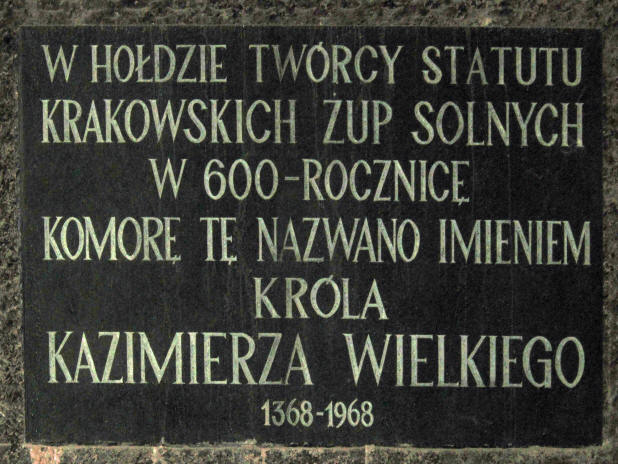
The royal founder of the Academy, Casimir the Great used the income from the Salt Mine to finance the new university, similarly, later monarchs and nobles did the same. It was Casimir the Great who, in 1368, laid down the principles of operation of the Mine in a statute later referred to as Statut Kazimierzowski (Casimir's Statute.) The document defines the duties and rights of individual officers and of various worker groups, providing also the bookkeeping regulations such as e.g. clearings with the State Treasury, and fixes the payments and manufacturer's prices of salt. Here are my shots of Casimir's statue in salt.
.jpg)
.jpg)
Here is a very nice shot of it I found and below that, my shot of a closer look at the depictions on the pedestal - all carved in salt.
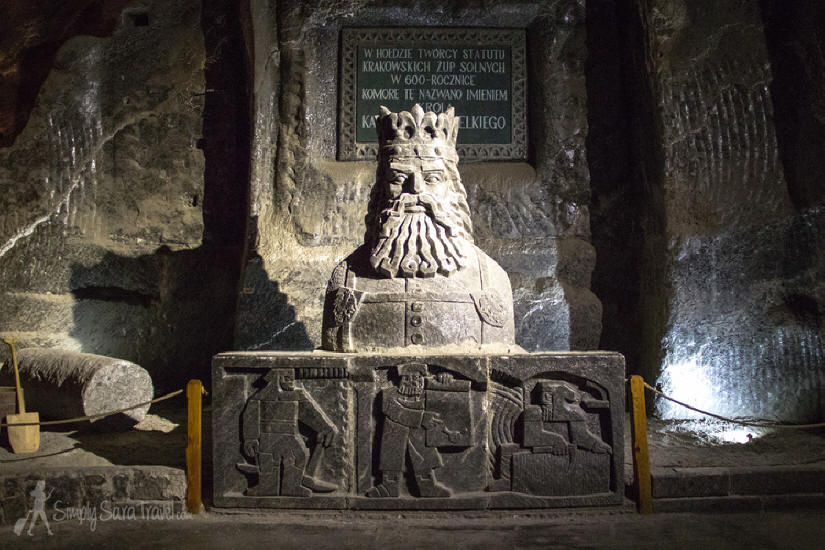
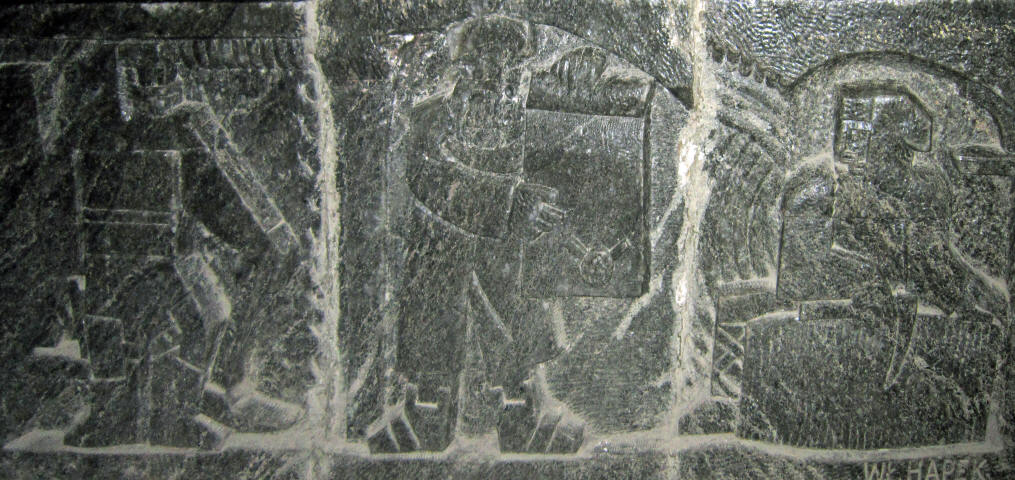
Here you can see the drill marks in the salt rock of the walls. There were more dioramas.
.jpg)
.jpg)
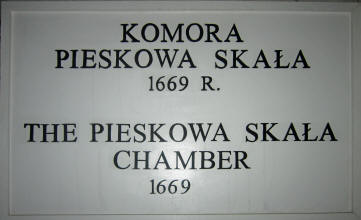
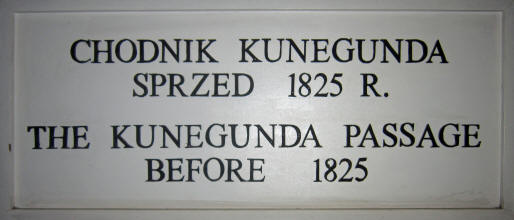
We then went into the Pieskowa Skała Chamber incline and finally headed down the Kunegunda Passage.
.jpg)
e.jpg)
e.jpg)
e.jpg)
This was a nice little climb down these stairs. I found a few better photos on the internet.
e.jpg)

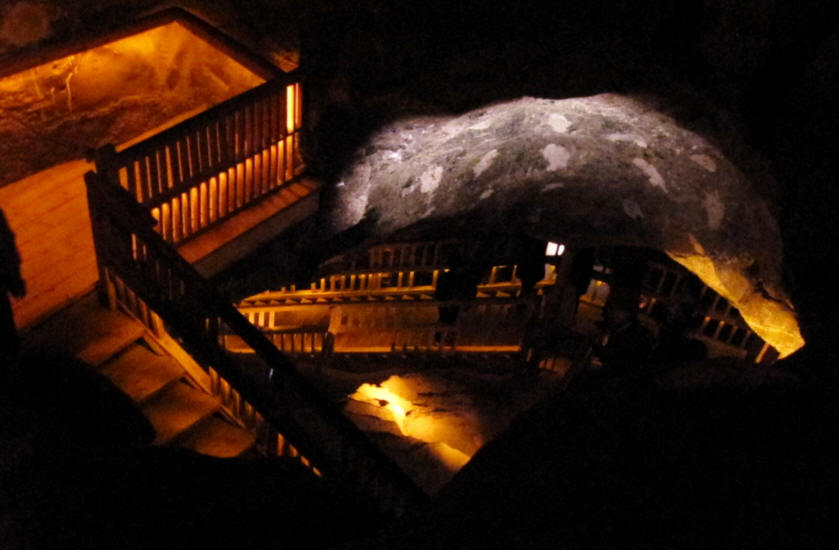
We got to this room with another mill, this time run by people power.
e.jpg)
.jpg)
It seems this mill was to pump water through this trough in the floor (below left) emptying into a cauldron (below right.) Water is a big problem if it enters the mine. The mine was actually closed down as a working salt mine in 1992 after a huge flood.
.jpg)
.jpg)
Here is a stock photo I found of the cauldrons.

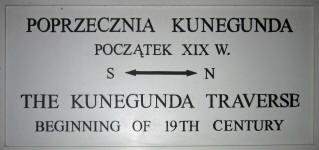
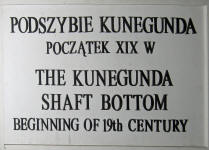
In the Kunegunda Traverse, you can see the miners liked little dwarves. On the left is a stock photo and the right is my Canon shot.
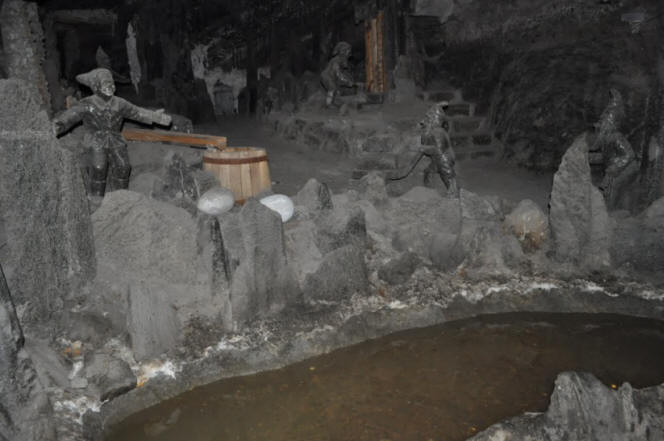
.jpg)
Again, more dioramas of the life of the miners.
e.jpg)
.jpg)
We then entered the St. Kinga Holy Cross Chapel from 1860. Below right is a sign in Polish, English, German, French and Hebrew.
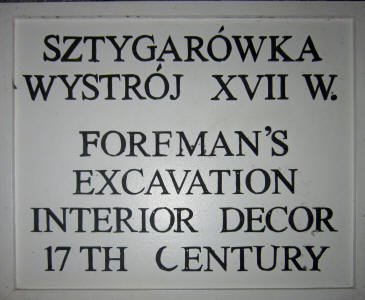

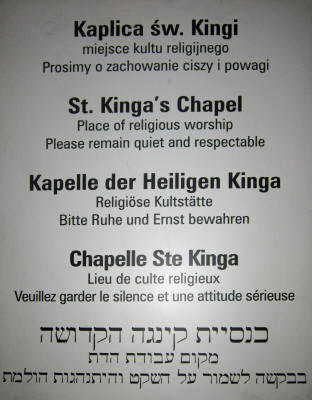
This area was rather modern with fancy tile floors.
e.jpg)
e.jpg)
Here are my close-ups of the statue of Mary and the Infant and the Crucifix in the chapel. This little girl was very cute.
.jpg)
.jpg)
.jpg)
Then, before you climb down the stairs, you get this view of the huge chapel (GoPro left, Canon right.) This immense space can hold weddings and public events and can seat over 400 people. The dimensions of the chapel are as imposing as the beauty of the interior decoration. The height of the chapel is 32 ft (10 m,) its length 50 yds (54 m,) and width 16 yds (15 m.)
e.jpg)
.jpg)
Once I got down the stairs I got a shot of the room (as those above) from the stairway (left) and then walked to the other end and got a shot looking the other way toward the stairs (right, both GoPro.)
e.jpg)
e.jpg)
Along the walls of the chapel are many religious carvings in the salt walls done by the miners. Below is the "Last Supper" (GoPro left, Canon right.)
e.jpg)
.jpg)
Then there is the depiction of the "Calvary of the Miners" which was just done in 2010.
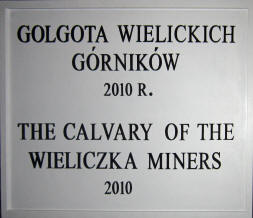
.jpg)
.jpg)
Then again is St. Kinga's Chapel with St. Kinga's salt statue holding the rock salt (below left,) a statue of Mary lit up (center) and another with God the Father above Mary and the Infant (right.)
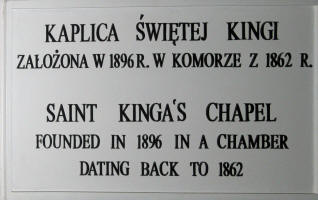
.jpg)
.jpg)
.jpg)
Then there is a carving of the Way of the Cross above Mary and Joseph fleeing to Egypt (below Left) and the three Magi visiting the Infant (right.)
.jpg)
.jpg)
Then there was one depicting the Wedding at Cana (below left) and depicting "Doubting Thomas" (right.)
.jpg)
.jpg)
I couldn't make this one out but it was quite detailed.
.jpg)
Then there is the main altar for services (below left) and a side chapel (right.)
.jpg)
.jpg)
Here is a much better photo I found of the altar area with the fully-lit salt chandelier above.
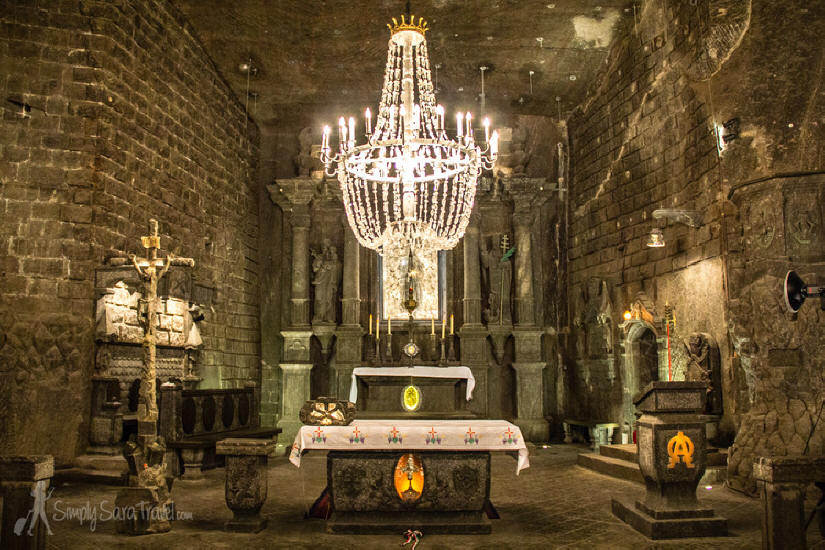
And, of course, I had to get the statue of St. Pope John Paul II done in 2001 (Canon left, stock photo right.)
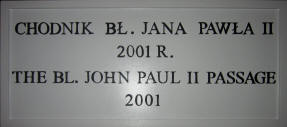
.jpg)
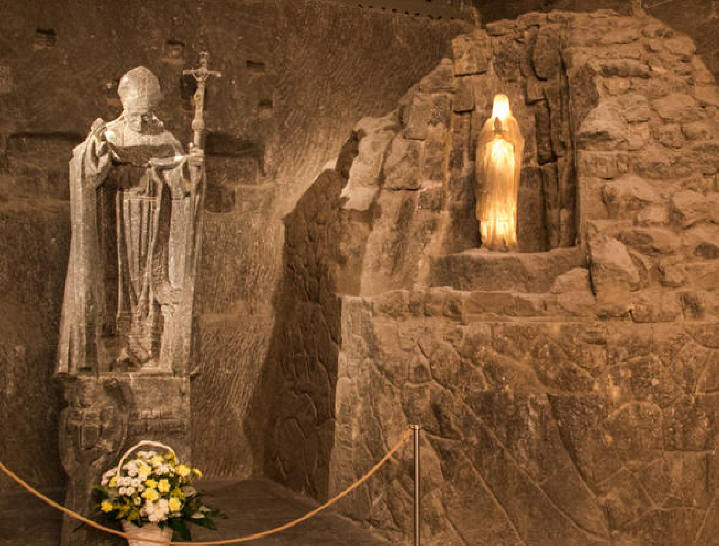
On the left is the plaque to John Paul II and on the right are plaques celebrating famous people.
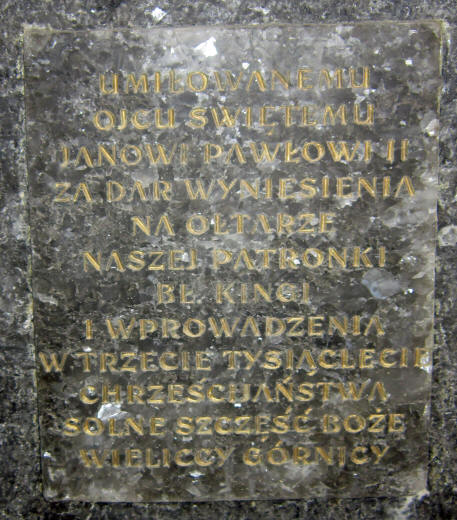
.jpg)
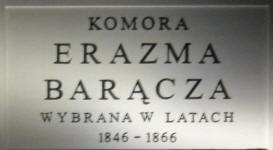
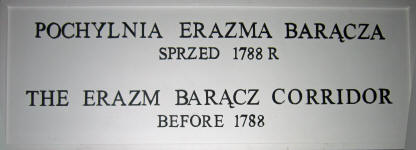
Now we approach one of the underground salt lakes. This one is in the Erazm Barącz corridor started before 1788. The salt content here is 320 g/l (43 oz/gal.) The Dead Sea salt content is 340 g/l. From here we go through some more wood-lined tunnels.
e.jpg)
e.jpg)
Honestly, sorting out all the photos from both the Canon and GoPro cameras became very confusing as far as sequencing them in order along with the signage I had photographed. I found this very nice map of the mines and it seems that the order I have listed is not exactly correct as depicted in this map.
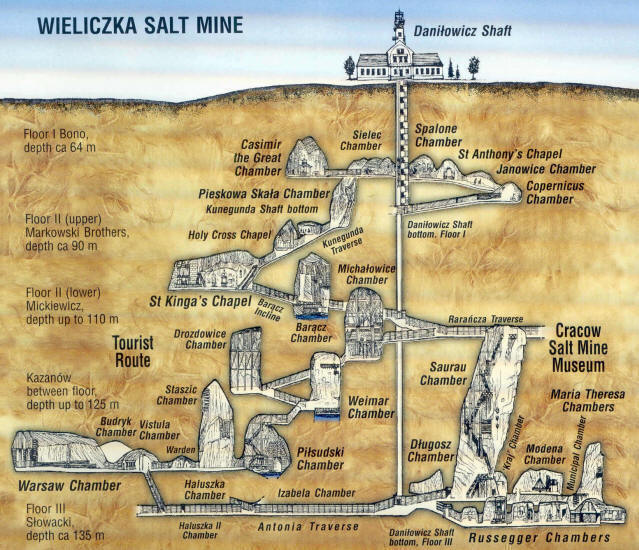
Here I list what seems to be the logical order of the tour:
Daniłowicz Shaft, Copernicus Chamber, Janowicz Chamber, St. Anthony's Chapel, Spalone Chamber, Sielec Chamber, Casimir Chamber, Pieskowa Chamber, Kunegunda Shaft Bottom, Holly Cross Chapel, St. Kinga's Chapel, Barącz Incline, Barącz Chamber, Michałowice Chamber, Rarancza Traverse, Weimar Chamber, Drozdowicz Chamber, Pilsudski Chamber, Staszic Chamber, Warden, Vistula Chamber, Budryk Chamber, Warsaw Chamber, Haluszka Chamber, Antonio Traverse, Izabela Chamber, Dlugosz Chamber, Russegger Chambers, Elevator.
Here is the map enlarged to show from getting down the stairs at the Daniłowicz Shaft and heading up to the Copernicus Chamber then up and over to the Casimir Chamber, down the Pieskowa Skała and Kunegunda to the massive St. Kinga Chapel and to where we are now; the Michałowice Chamber.
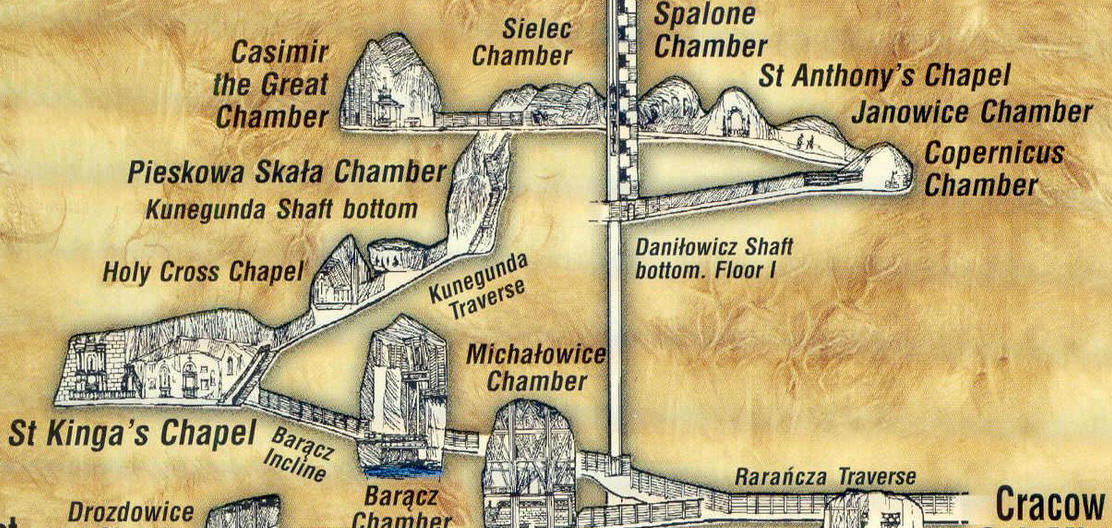
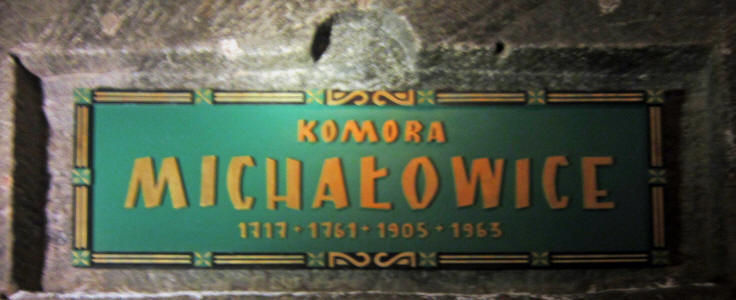

From here we enter the Michałowice Chamber started in 1717.
Here (below left) is the ceiling of the chamber.
e.jpg)
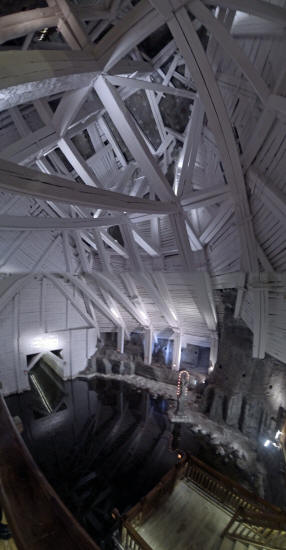
We climbed down this large beautiful chandeliered staircase.
.jpg)
.jpg)
Here is a stock photo I found (below left) next to two shots I made with PhotoStitch.
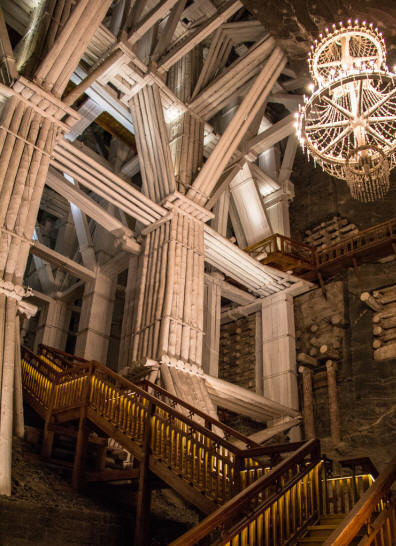
.jpg)
.jpg)
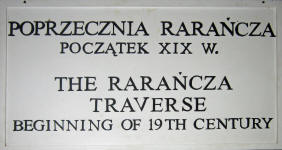
We went through the Rarańcza Traverse.
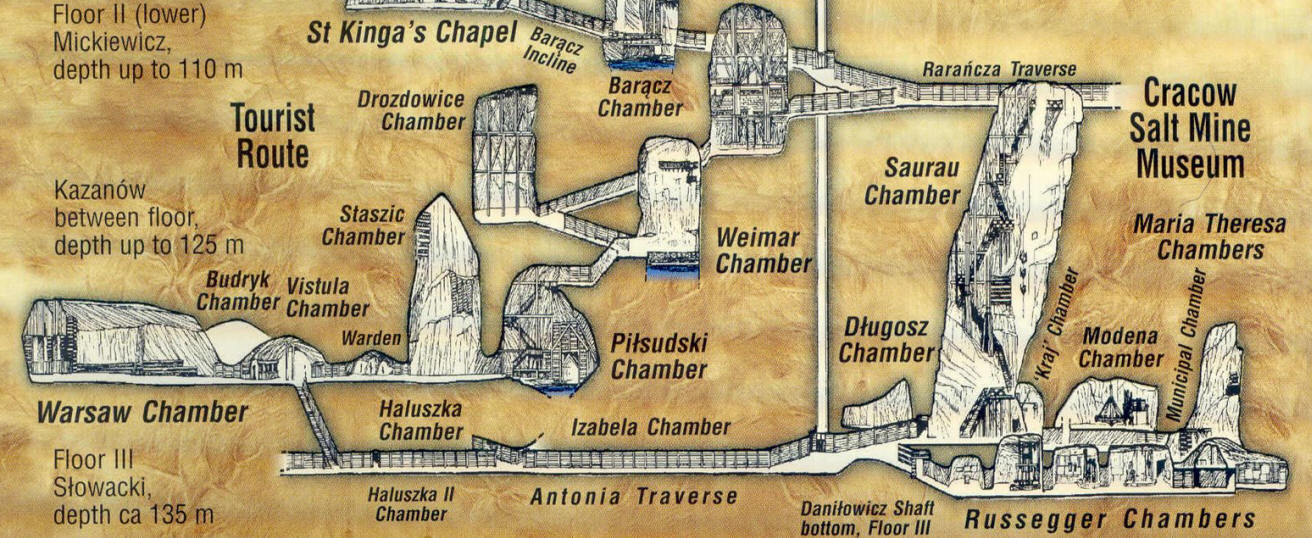
Above is the lower portion of the map showing us leaving the Michałowice Chamber and heading down into the Drozdowice Chamber, then down to the Weimar Chamber and further down into the Piłsudski Chamber.
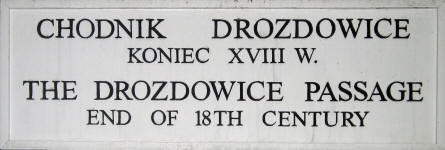
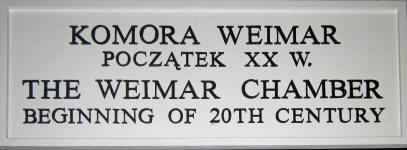
We then went through the Drozdowice Chamber from the end of the 1700s into the Weimar Chamber started in the early 1900s. Here they have a salt statue of one of the tourists, Johann Wolfgang von Goethe.
e.jpg)
e.jpg)
.jpg)
We then entered the J�zef Piłsudski Grotto and ...
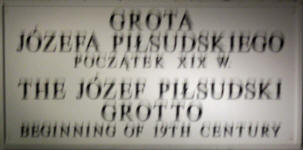
.jpg)
.jpg)
... the Piłsudski
Chamber with a salt statue of him.
J�zef Klemens Piłsudski
(left)
(1867�1935)
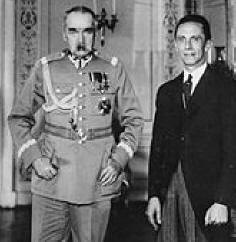 was
an important controversial Polish
was
an important controversial Polish
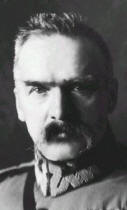
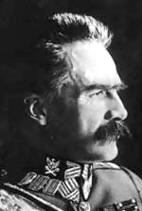 statesman;
Chief of State (1918�22,) "First Marshal of Poland" (from 1920) and de facto
dictator (1926�35) of the Second Polish Republic. From the middle of
WW I, he had a major influence in Poland's politics, and was an important figure
on the European political scene. He was the person most responsible for
the creation of the Second Republic of Poland in 1918, 123 years after it had
been taken over by Russia, Austria and Prussia. Because France and the UK
were appeasing Hitler, Piłsudski signed non-aggression pacts with both its
powerful neighbors: the 1932 Soviet-Polish Non-Aggression Pact, and the 1934
German-Polish Non-Aggression Pact. Above right is his photo (left) with
Joseph Goebbles (right) while signing the pact. He died before seeing
Hitler blitzkrieg his country in 1939. Below left is a stock photo of his
salt statue here and on the right is mine.
statesman;
Chief of State (1918�22,) "First Marshal of Poland" (from 1920) and de facto
dictator (1926�35) of the Second Polish Republic. From the middle of
WW I, he had a major influence in Poland's politics, and was an important figure
on the European political scene. He was the person most responsible for
the creation of the Second Republic of Poland in 1918, 123 years after it had
been taken over by Russia, Austria and Prussia. Because France and the UK
were appeasing Hitler, Piłsudski signed non-aggression pacts with both its
powerful neighbors: the 1932 Soviet-Polish Non-Aggression Pact, and the 1934
German-Polish Non-Aggression Pact. Above right is his photo (left) with
Joseph Goebbles (right) while signing the pact. He died before seeing
Hitler blitzkrieg his country in 1939. Below left is a stock photo of his
salt statue here and on the right is mine.
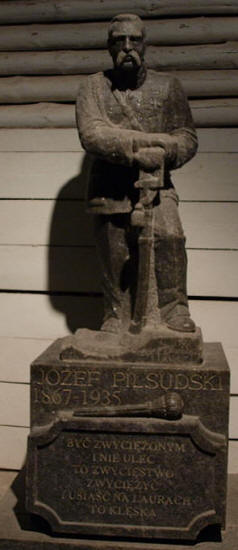
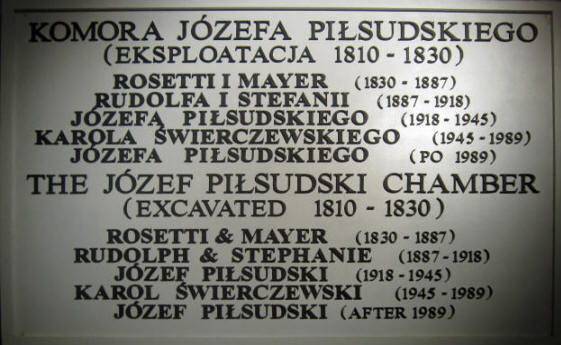
.jpg)
 We
then enter the very tall Stanislaw Staszic Chamber.
Stanisław Wawrzyniec
Staszic
We
then enter the very tall Stanislaw Staszic Chamber.
Stanisław Wawrzyniec
Staszic
(right)
(1755�1826) was a leading figure in the Polish Enlightenment. He was a
Catholic priest, philosopher, geologist, writer, poet, translator and statesman.
He co-founded the Warsaw Society of Friends of Learning (precursor to the Polish
Academy of Sciences,) of which he became president. He served as a member
of the State Council of the Duchy of Warsaw and as minister of trade and
industry in the Congress of Poland. Staszic is seen as the father of
Polish geology, statistics, sociology, Tatra Mountains studies and exploration,
mining and industry. The photos of the Chamber below could only be taken
using the GoPro camera.
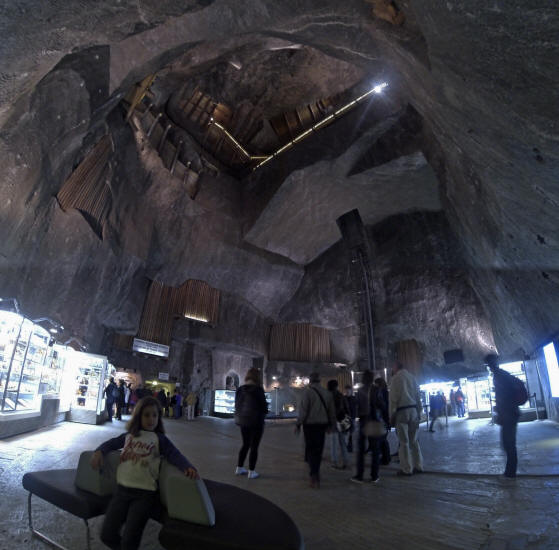
e.jpg)
Below left is a GoPro shot of looking up at the ceiling of this room. There was also a place called the Scarbnik, The Treasurer.
e.jpg)
e.jpg)
e.jpg)
e.jpg)
From here this led to the three exits; those for groups, those for individuals and those wanting to go to the Museum.
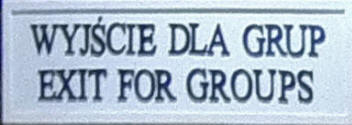


Somewhere along the Kazanow Split-Level and the Poniastowski Traverse, I got this shot of the rails and an old tram that can run in these tunnels.
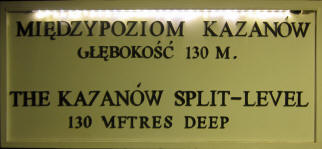
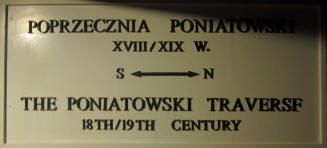
.jpg)
As is always the case, the end of a tour drops you into a massive gift shop. There were many neat things for sale made out of the rock salt but for some reason I didn't buy anything that I can recall. They had this map on the wall which I really couldn't make out. They were also selling tickets to the much more rigorous "Miner's Route" which I knew I would not be taking.
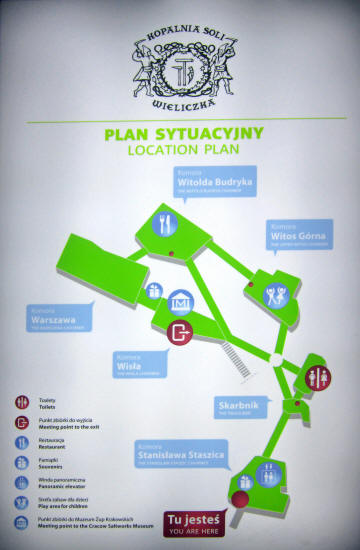
.jpg)
Just as we were heading toward the elevator, I passed the St. John's Chapel.
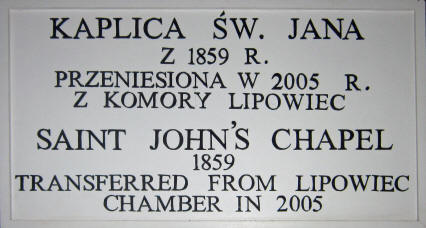
.jpg)
At last, we reached the elevator to the top and this (below left) is the only quick shot I got of it before being squeezed into it with a lot of other people. Below is a stock photo of it I found.
.jpg)
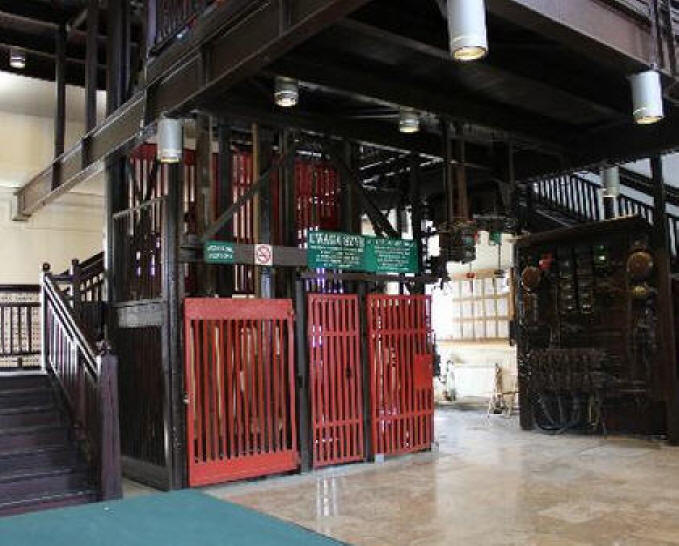
I don't remember the ride up the elevator being very long, but was happy when
the doors opened and let me out. I did it - I toured the famous Salt Mines
of Krakow. Here is a
SITE with much
historical information on the Salt Mines. While I was going through all this
it become so warm down there that I had removed most of the warm clothing I
could and tied it around my waist. Meanwhile, at 6:10 PM
Marcia was still shopping in
 the
cold and rain and bought a raincoat at
Rossmann [ulica Pavia 5,
the
cold and rain and bought a raincoat at
Rossmann [ulica Pavia 5,
![]() +48-42-613-9700] and then at 7:20 PM
she went to the Chopin Concert at Wierzynck restaurant where we ate dinner last
night. The ticket cost only 60 zł and she really enjoyed it.
It was funny that her excuse for not wanting to go down into a "cold freezing
mine" because she was fighting a cold, turned out to be just the opposite.
I had to put my warm clothes back on once I was heading back to the car. I was finally
finished and at 8:00 PM
I drove back to the hotel which, without traffic, was a very quick ride. I
was back in 15 minutes.
+48-42-613-9700] and then at 7:20 PM
she went to the Chopin Concert at Wierzynck restaurant where we ate dinner last
night. The ticket cost only 60 zł and she really enjoyed it.
It was funny that her excuse for not wanting to go down into a "cold freezing
mine" because she was fighting a cold, turned out to be just the opposite.
I had to put my warm clothes back on once I was heading back to the car. I was finally
finished and at 8:00 PM
I drove back to the hotel which, without traffic, was a very quick ride. I
was back in 15 minutes.
 Marcia
was there, so we got ourselves together and headed out to have dinner at one
Marcia
was there, so we got ourselves together and headed out to have dinner at one
 of
the finest restaurants in Krakow. At 8:40 PM
we merely walked two doors (above) down the street to the acclaimed
Ancora Restaurancja II [ul. Dominika�ska 3,
of
the finest restaurants in Krakow. At 8:40 PM
we merely walked two doors (above) down the street to the acclaimed
Ancora Restaurancja II [ul. Dominika�ska 3,
![]() +48-12-357-3355.]
The head chef listed on their website now is Mariusz Gołdyn (left.) We
thought we would give it a try since it was right next door to our hotel.
Below are my shots of the place.
+48-12-357-3355.]
The head chef listed on their website now is Mariusz Gołdyn (left.) We
thought we would give it a try since it was right next door to our hotel.
Below are my shots of the place.
Here are some stock photos I found of the place.
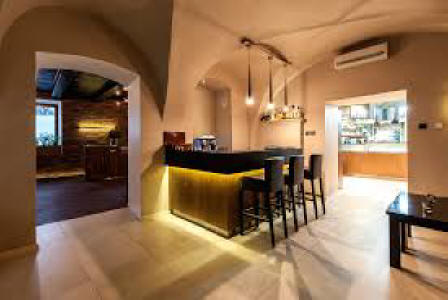
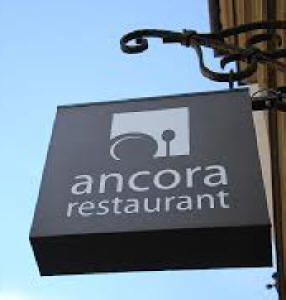
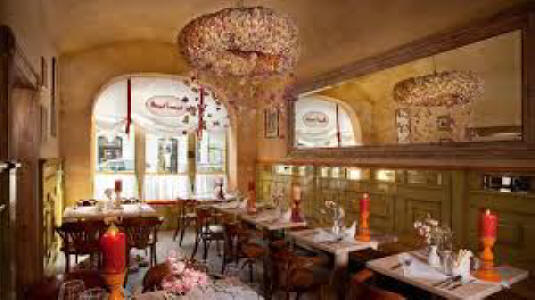
They gave us menus in Polish and English.
.jpg)
.jpg)
.jpg)
.jpg)
.jpg)
We were immediately brought an amuse bouche of raw herring roe (below left) with pumpernickel bread and sour cream (below right.) I don't eat anything raw, so I let Marcia have mine but when she tried it, she didn't like it.
Raw food is not a good start for me but we enjoyed the bread, however, and ordered a bottle of Perlage sparkling water and a bottle of 'Ntisu, a Sicilian wine from Costantino. I wanted to try a different local beer so I had a bottle of Roteckie.
We first ordered and shared a thing called "Snacks" (below left) which was 1) goat cheese with marinated beetroot (Kozia bryndza z marynowanymi burackami) (bottom dish,) 2) a Rilette of sausage with pickles (Okrasa z wiejskiej kielbasy z piklami) (right dish,) and 3) cucumber salad with heavy cream (Mizena na wiejskiej s'mietanie) (upper dish.) For my appetizer I had oxtail stuffed pierogi with dark beer emulsion, white bean and herbs salad (Pierogi z ogonem wotowym na emulsji z piwa porter I sałatce z biatej fasoli z ziotame) (below right.)
When I cut into my dish, I discovered they brought me cheese pierogis (above right.) I told the waitress the error and she brought me the correct ones (below left.) I cut into it to make sure it was meat (center.) I ate both the cheese AND the meat ones! They were both very good. For my entree, I ordered duck leg comfit with smoked prune and grilled chicory (Udko kacze z suską sechlońską i cykorią z rustu) (below right.)
Before my entree, they brought an Intermezzo of raspberry sorbet with coffee liquor and peppermint (Sorbet malinowy z likierem kawowym I miętą ) (below left.) For her entree, Marcia had filet of halibut on forest fruits sauce served with broccoli and cauliflower (filet halibuta na sosie z owoc�w les'nych podany z kalafiorem I brocutem) (below right.)
Our
waitresses were Anna and Joanna and we rated this dinner
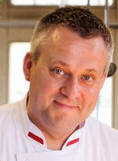 Excellent-Fabulous.
Head Chef and Co-owner Adam Chrzastowski was a
student of our famous Thomas Keller of the French Laundry in Napa Valley
(Yountville, CA.)
Based on this dinner, he sure learned a few things.
Excellent-Fabulous.
Head Chef and Co-owner Adam Chrzastowski was a
student of our famous Thomas Keller of the French Laundry in Napa Valley
(Yountville, CA.)
Based on this dinner, he sure learned a few things.
We left there at
11:00 PM and went next
door to the Beergallery [Dominika�ska
3,
![]() +48-60-140-8870] where I had my cappuccino this morning.
I ordered a Ksią�ęce beer (in a Zubr glass) and Marcia had a red wine
and both cost us 16 zł. We were the only ones in the place. I forgot
our bartender's name but he was very nice and took good care of us.
+48-60-140-8870] where I had my cappuccino this morning.
I ordered a Ksią�ęce beer (in a Zubr glass) and Marcia had a red wine
and both cost us 16 zł. We were the only ones in the place. I forgot
our bartender's name but he was very nice and took good care of us.
Here are some photos of the place from their website.

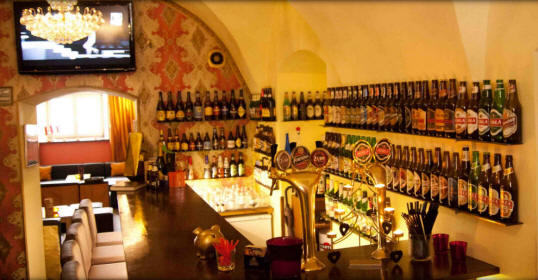
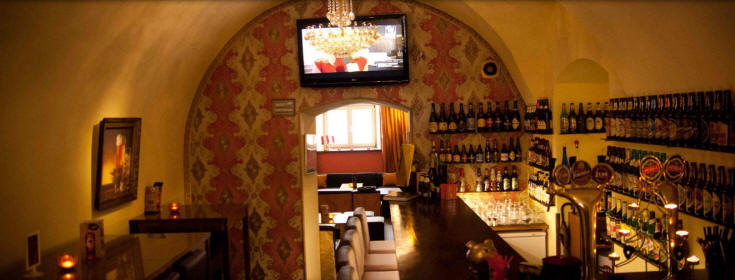
We left there at 11:40 PM and our hotel was right next door. This was a long and exhaustive day and we got to bed at 2:00 AM. Tomorrow will be even longer when we tour Auschwitz.
Kenneth J. Hoffer, MD
Krak�w, Poland
Sent 2-15-2015
If you enjoyed these travels or wish to add comments on the places we visited
Please Leave Me a Message by clicking the spinning @ sign below.

